VILMAR NUMISMATICSllc FIXED PRICE LIST V



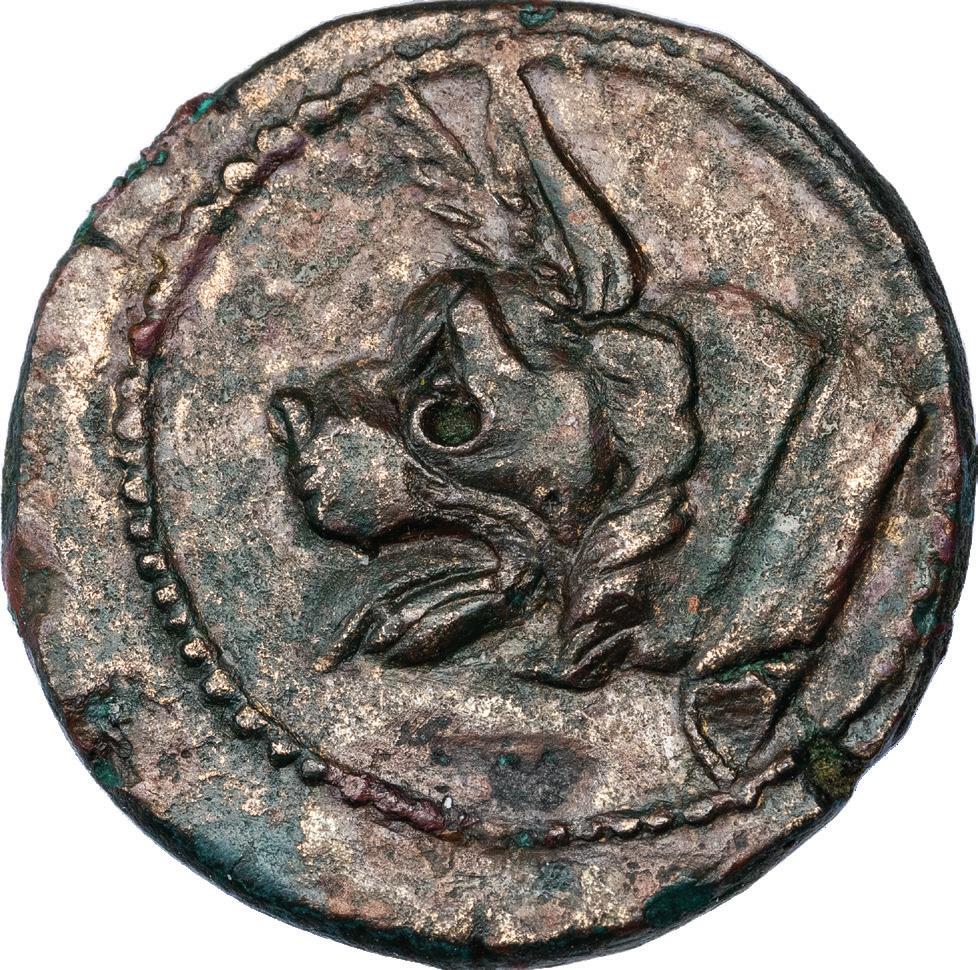
Vilmar Numismatics LLC PO Box 60 Big Indian, NY 12410 vilmar@aol.com www.vilmarnumismatics.com FIXED PRICE LIST V SUMMER/FALL 2023
FIXED PRICE LIST V: COINS FROM OLD COLLECTIONS
We are pleased to offer our Fixed Price List V which features a broad range of old provenanced material. Provenance takes many forms and is increasingly important in today’s market. Famous and prestigious collectors’ pieces are eagerly sought after, especially those dating to the beginning of the 20th century and earlier. Collecting is an ongoing pursuit and new names (or nicknames) of collectors continually appear on the market. Every dealer has customers who have begun to de-acquisition coins, whether their complete collection, duplicates, or the occasional odd purchase of a wonderful coin which no longer fits in their collecting area. Family trees of a coin’s ownership continue to be ever-expanding, and various services such as Ex-Numis and CoinArchives provide tools to assist in tracking a coin’s past.
Fixed Price List V presents a bit of everything in terms of provenance. There are pieces from great collections, such as those of Dr. Samuel Pozzi, Frèderic-Robert Jameson, Archer M. Huntington, Vicomte de Sartiges, Sigmund Krausz, Michael Vlasto and others. There are also pieces from notable collections that have been recently sold at auction, including those of William Stancomb, Arthur Houghton, Hermann Lanz, the “Berlin Surgeon,” Mark and Lottie Salton, and David Hendin. In many cases, further research reveals additional pedigrees, notably for several of the Salton collection pieces. Personally, some of the people whose names appear here are individuals whom I have met over my career – David Hendin and Arthur Houghton, friends of many decades, have helped and taught me throughout the years; William Stancomb, with whom I have corresponded on various academic matters regarding Black Sea numismatics following our first meeting in 2001; and Mark Salton, a fellow member of the New York Numismatic Club I knew from attending meetings long ago.
Every dealer also has his treasured relationships with individual collectors, and it is a distinct pleasure when we are entrusted with our old numismatic “children,” thereby having another chance to offer them to a new generation of collectors. You will note that many coins in this catalogue come from a man identified as the “Southern Collector.” He is a close friend for nearly two decades, an academic who collects in various fields, including numismatics. He delights in the aesthetics of ancient coins, the history behind their types and their provenance. Having recently retired after teaching 30 years, the Southern Collector has decided to part with some of his coins because he will no longer use them in class as teaching tools. Many came from Vilmar Numismatics over the last decade or were acquired on his behalf at public auction.
Quite a few coins, even when they are not associated with specific collectors, have been published in numismatic monographs and articles. We have a number of these here as well, including a Siculo-Punic tetradrachm published by Jenkins, a Lysimachus published by Wolfgang Fischer-Bossert, two medallions depicting Labors of Heracles, both of which appear on RPC Online, and a rare contorniate published twice by Alfoldi.
It is our hope that you enjoy the coins described in these pages.
LLC
Constantin Marinescu & the staff at Vilmar Numismatics,
1 (18177). CELTS ON LOWER DANUBE. 2nd-1st centuries BC. Silver tetradrachm using types of “First Meris” tetradrachms, 16.93 g, 33 mm. Obv. Draped bust of Artemis right, within decorated Macedonian shield. Rev. ΜΑΚΕΔΟΝΩΝ ΠΡΩΤΗΣ, club right, AYP control monogram above, all within wreath, thunderbolt in extreme left field.
R. Göbl, Ostkeltischer Typen Atlas (Braunschweig, 1973), pl. 2, E4 (same dies); Kostial 1008 (this coin listed and illustrated). Ex Hermann Lanz Collection; ex Roma Numismatics XVIII, 9/29/2019, lot 245; ex John Work Garrett Collection, Bank Leu/NFA Sale, 10/16/1984, lot 85.
NGC graded CHOICE XF, Strike 5/5, Surface 4/5, “light marks.”
2 (18493). CALABRIA. TARENTUM. Ca. 281-240 BC.
Silver didrachm (nomos), 6.36 g, 21 mm. Issue of magistrate Philiscus. Obv. Youthful rider right, crowning his horse, ΦΙΛICKOC below. Rev. TAPAΣ, dolphin rider left, holding cantharus, tripod below. HGC 1, 891; Vlasto 888; HN Italy 1036.


Ex Salton Collection, likely acquired in the 1950s-1960s when Mr. Salton owned a numismatic firm in New York.
NGC graded VF, Strike 4/5, Surface 3/5, “graffito” noted (letter A on reverse), dark gray cabinet patina.
The reverse type has been variously described as representing Taras, the son of Poseidon and eponymous founder of Tarentum, or Phalanthos, the semi-legendary leader of the group of Spartan colonists that set out to settle at Tarentum in ca. 708 BC. The colonists had been instructed by the Delphic Oracle to establish a new city in southern Italy, but Phalanthos was shipwrecked on the way. Not wishing his oracle’s prophecy to be shown as false, the god Apollo sent a dolphin to save Phalanthos from drowning and to lead the colonists to the site of the new settlement.
3 (18496). CALABRIA. TARENTUM. Ca. 240-228 BC. Silver didrachm (nomos), 6.63 g, 20 mm. Issue of magistrate Xenocrates. Obv. ΞΕΝΟΚΡΑΤΗΣ, bearded rider left, saluting, TK control monogram and pileus in upper right field. Rev. TAPAΣ, dolphin rider left, holding trident and his drapery, Σ control monogram in right field, stylized waves below with cuttlefish to the right.


HGC 1, 904; HN Italy 1058; SNG ANS 1259. Ex Salton Collection, likely acquired in the 1950s-1960s when Mr. Salton owned a numismatic firm in New York.
NGC graded CHOICE XF, Strike 3/5, Surface 3/5, iridescent highlights over gray toning, popular variety with the cuttlefish symbol.
Tarentum had a reputation for its horses and a distinctive type of cavalry training, which focused on producing skilled unarmored horsemen armed with javelins and often carrying a large shield. Such Tarentine cavalrymen were employed as mercenaries in many armies throughout the Hellenistic world and aspects of their training were regularly depicted on the nomoi of Tarentum in the third century BC.
5
A RARE TARENTINE GOLD HALF-STATER ONCE OWNED BY


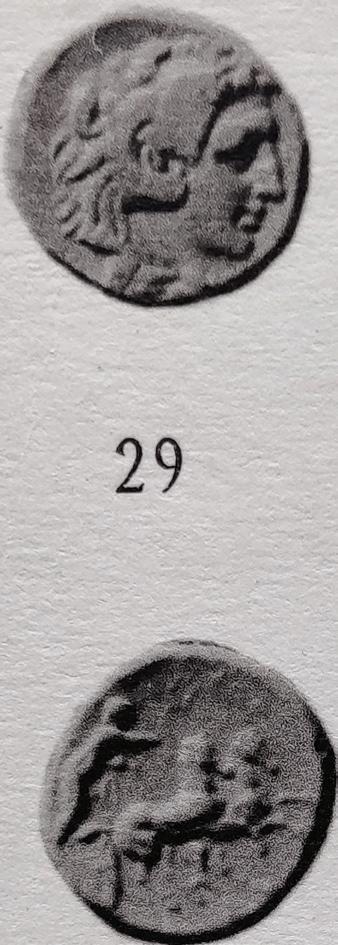

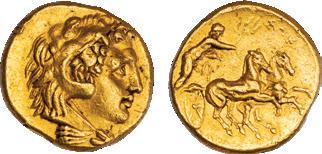 MICHEL P. VLASTO AND PLATED IN HIS
MICHEL P. VLASTO AND PLATED IN HIS
WORK
4 (17445). CALABRIA. TARENTUM. Ca. 280-272 BC. Gold half-stater, 4.28 g, 13 mm. Obv. Head of young Heracles right in lion skin headdress. Rev. TAPANTINΩN, charioteer (Taras?) driving biga right, holding trident, ΣΩK above.
Fischer-Bossert G33f (this coin listed); Vlasto 29 (this coin listed and illustrated on pl. II); HN Italy 985; HGC 1, 737. Ex Bank Leu 48, 5/10/1989, lot 10.
NGC graded CHOICE XF, Strike 4/5, Surface 3/5, FINE STYLE, “edge scuff,” few marks in fields, a coin with a distinguished pedigree and publication history.
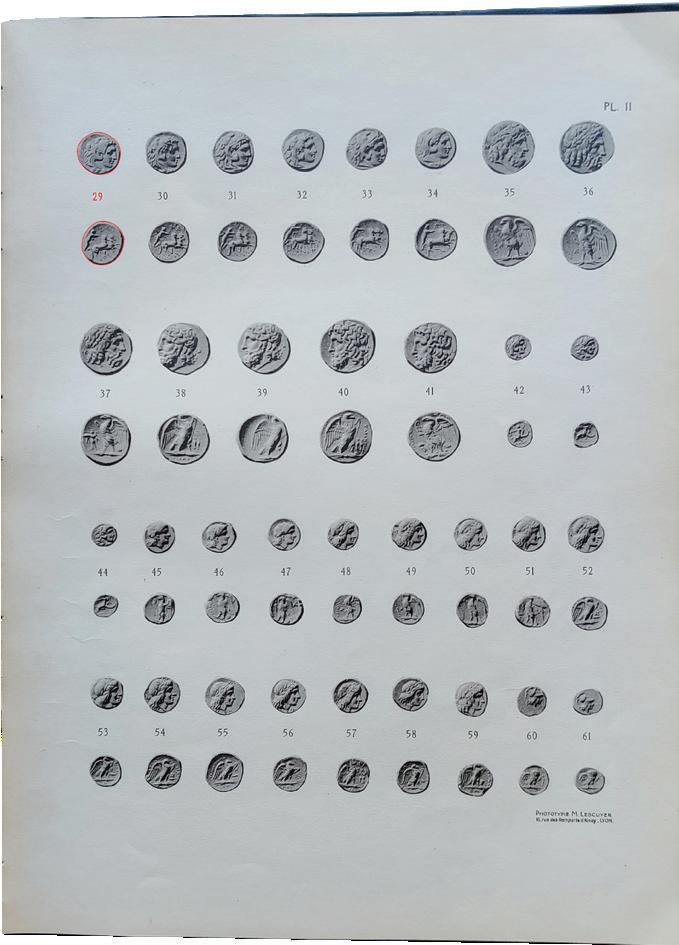
6
FACING DEMETER HEAD METAPONTUM STATER FROM THE POZZI AND LOCKET COLLECTIONS


5 (17756). LUCANIA. METAPONTUM. Ca. 330-280 BC.

Silver stater, 7.66 g, 20 mm.
Obv. Wreathed head of Demeter facing three quarters right, AΠ in right field. Rev. META, ear of grain, facing bull’s head and ΑΘ[Α] in right field.
Johnston, Metapontum, Class C, 2.7 (same dies); Pozzi 196 (this coin listed and illustrated); SNG Lockett 417 (this coin listed and illustrated).


Ex Baldwins 44, 5/2/2006, 10 = Sotheby’s 4/19/1993, lot 269 = Lockett Collection, Glendining, 10/25/1955, lot 303 = Pozzi Collection, Naville 3/14/1921, lot 196.
NGC graded XF, Strike 4/5, Surface 3/5, steel gray cabinet patina with iridescent highlights.

7
6 (18637). SICILY, GELA. Circa 420-415 BC.

Silver tetradrachm, 16.41 g, 25 mm.
Obv. Charioteer driving quadriga left, Nike flying above left, crowning horses; [in exergue, lizard left, about to catch fly]. Rev. CEΛAΣ, forepart of man-headed bull left.
Jenkins, Gela, Group VIII, 469 (O91/R181); HGC 2, 355.
Ex CNG Electronic Auction 531, lot 40 = Dr. Michael Slavin Collection, acquired privately from Classical Cash, November 24, 2001. NGC graded CHOICE XF, Strike 3/5, Surface 3/5, FINE STYLE, “overstruck”.
This is a very puzzling coin with what seems to to be a prominent overstrike. The undertype may be an Arethusa-like head wearing a saccos and facing left, but not all elements of the supposed host coin readily match. Therefore, we may be dealing with a highly unusual planchet irregularity that has been flattened during the striking process.



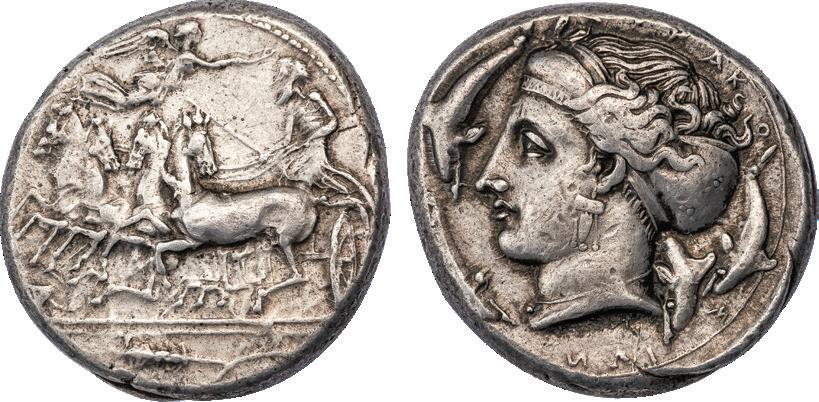

7 (18499). SICILY. SYRACUSE. Ca. 430-420 BC.
Silver tetradrachm, 16.73 g, 25 mm.
Obv. Charioteer driving biga right, Nike flying above left, crowning him. Rev. ΣΥΡΑΚΟΣΙΟΝ, head of Arethusa right, wearing saccos, four dolphins around.
HGC 2, 1318; Boehringer 632.
Ex Salton Collection, likely acquired in the 1950s-1960s when Mr. Salton owned a numismatic firm in New York. NGC graded VF, Strike 4/5, Surface 3/5, FINE STYLE, “edge marks.”
8 (18874). SICILY. SYRACUSE. Ca. 405-367 BC.


Silver tetradrachm, 17.29 g, 24 mm. Issue of ca. 405-400 BC.
Obv. Charioteer driving quadriga left, Nike flying above right, crowning him, ivy leaf below horses, grain stalk left in exergue. Rev. [ΣΥΡ]ΑΚΟΣ[ΙΟΝ], diademed head of Arethusa left with possible signature on sphendone, wearing saccos decorated with stellar pattern, a pair of dolphins swimming downward in left field, another pair, playfully jumping one above the other, in right field.
Fischer-Bossert, Coins, Artists, and Tyrants, 83e (O30/R56, this coin listed) = Tudeer 83; HGC 2, 1342; SNG ANS 291 (inv. 1944.100.55795, same dies).
Ex CNG 7, 5/4/1989, lot 16 = Schweizerische Kreditanstalt Bern Auction 3, 4/19/1985, lot 126.
NGC graded CHOICE VF, Strike 5/5, Surface 4/5, FINE STYLE, “lt. marks,” a coin with a charming reverse where one dolphin appears to jump above another that emerges from behind Arethusa’s neck. Although Tudeer and Fischer-Bossert regard this as an unsigned issue, there seems to be a signature on the upper part of the sphendone.
8
9 (18841). SICILY. SYRACUSE. PHILISTIS, WIFE OF HIERON II, 275-215 BC.
Silver tetradrachm (16 litrai), 13.57 g, 27 mm. Issue of 240-218/5 BC. Obv. Diademed and veiled head left, star in right field. Rev. BAΣIΛIΣΣAΣ ΦIΛIΣTIΔOΣ, Nike driving quadriga right, star above, K in right field.

Caltabiano, Carroccio, et al, Siracusa ellenistica: Le monete ‘regali’ di Ierone II, della sua famiglia e dei Siracusani (Messina, 1997), 108 (D7/R18); HGC 2, 1556.
Ex Southern Collector, acquired from CNG 108, 5/16/2018, lot 21; ex Comte René Philipon (1870-1936), Parsy, 3/23/2016, lot 12. Good VF, some encrustation on reverse, light edge marks.
Tetradrachms, such as the present piece, are believed to have been struck following the conclusion of the First Punic War (264-241 BC), after which Hieron II of Syracuse was recognized by the Romans as a client-king ruling over much of southeastern Sicily. They provide the only evidence we have for the appearance and name of Hieron’s wife.




This coin comes from the collection formed by René Philipon, a French devotee of Rosicrucian and Martinist esotericism who styled himself comte (“count”) after his rank within the Catholic chivalric Equestrian Order of the Holy Sepulcher of Jerusalem. Ironically, he was born the very year that hereditary titles of nobility were permanently abolished by the French Republic.
PUBLISHED IN JENKINS AND PROVENANCED TO THE HESS-LEU SALE OF 1958
10 (18849). SICILY. SICULO-PUNIC. Ca. 320-300 BC.
Silver tetradrachm, 17.19 g, 24 mm. Issue of Entella (?). Obv. Head of Arethusa/Persephone left, dolphins around, caduceus in left field. Rev. Horse’s head left with large palm behind, Punic letters M M in exergue.

Jenkins, Coins of Punic Sicily, 227 (this coin cited).

Ex Southern Collector, acquired from Vilmar Numismatics in 2019; ex Gorny & Mosch Giessener Münzhandlung 232, 10/5/2015, lot 88 = Hess-Leu 9, 4/2/1958, 114.

NGC graded CHOICE XF, Strike 5/5, Surface 4/5, “lt marks,” boldly struck in high relief, with light gray cabinet patina.

9 PHILISTIS TETRADRACHM FROM THE COLLECTION OF COMPTE PHILIPON
A PAIR OF PUBLISHED ALEXANDER-TYPE TETRADRACHMS FROM THE BLACK SEA CITY OF ODESSUS


11 (14793). THRACE. ODESSUS. Ca. 125-70 BC.
Silver tetradrachm of Alexander type, 16.04 g, 29 mm.
Obv. Head of Heracles right, wearing lion skin, the face with the features of Mithridates VI of Pontus. Rev. ΒΑΣΙΛΕΩΣ
Zeus enthroned left, holding scepter and eagle, ΘE in left field, ΟΔΗ monogram under throne. Price 1184; Kostial 872 (this coin listed and illustrated).
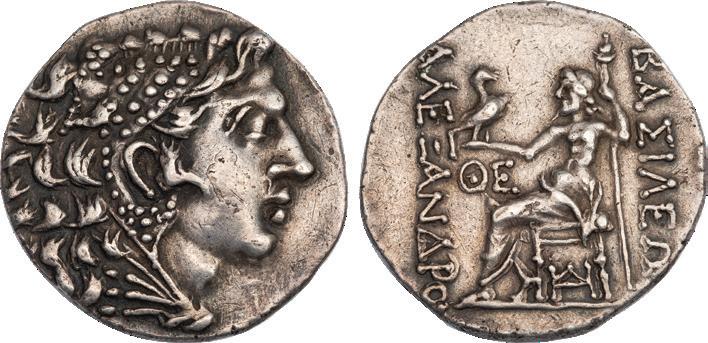


Ex Hermann Lanz Collection; ex Roma Numismatics XVIII, 9/29/2019, lot 215; exhibited at the Staatlichen Münzsammlung München for the 1997 International Numismatic Congress in Berlin as well as at the Berliner Bank during the same year


NGC graded CHOICE XF, Strike 5/5, Surface 3/5, a variety where Heracles’ face bears the features of Mithridates VI, echoing the famous marble bust in the Louvre Museum. Mithridates styled himself as a new Alexander, protecting the Greek world from the expanding Roman empire.
12 (15330). THRACE. ODESSUS. Ca. 125-70 BC.
Silver tetradrachm of Alexander type, 15.36 g, 30 mm.
Obv. Head of Heracles right, wearing lion skin, the face with stylized features recalling those of Mithridates VI of Pontus. Rev. ΒΑΣΙΛΕΩΣ ΑΛΕΞΑΝΔΡΟΥ, Zeus enthroned left, holding scepter and eagle, ΘE in left field, ΟΔΗ monogram under throne.
Price 1184; SNG Stancomb 269 (this coin listed and illustrated).
Ex William Stancomb Collection; ex Roma Numismatics XIX, 3/26/2020, lot 16 with the additional information as acquired from P. Beirne in July 1988.
NGC graded XF, Strike 4/5, Surface 3/5, “slight bend.”
10
ΑΛΕΞΑΝΔΡΟΥ,
13. 18339. KINGDOM OF THRACE. LYSIMACHUS, 305-281 BC.

Silver tetradrachm, 16.98 g, 28 mm. Lifetime issue of an uncertain mint in Thrace, ca. 285-281 BC.


Obv. Head of deified Alexander the Great right, with the horn of Ammon. Rev. ΒΑΣΙΛΕΩΣ
Athena enthroned left, holding Nike crowning Lysimachus’ name, herm in left field.
Fischer-Bossert, Lysimacheier, 23a (V6/R20, this coin listed and illustrated); Thompson –; Müller -.

Ex Stack’s, 12/2/1998, lot 73 = Numismatic Fine Arts XXXI, 3/18/1993, lot 97.

NGC graded CHOICE AU, Strike 5/5, Surface 3/5, “marks,” boldly struck with great detailing and eye appeal, gray toning.
Posthumous Lysimachi of this type have often been attributed to Ainus (or Sestus) in Thrace, largely based on the herm symbol, although securely attributed issues of Ainus always depict the enthroned cult image of Hermes Perpheraius rather than a herm. Instead, as Wolfgang Fischer-Bossert has shown, the present herm issue should be associated with a group of Lysimachi struck in the name of an obscure Thracian or Galatian dynast named Scostocus at an uncertain mint in Thrace. Both the anonymous specimens bearing Lysimachus’ name, like the present piece, and the issues naming Scostocus share obverse dies.
AN EXCEEDINGLY RARE ISSUE OF THE EARLY TRIDENT COINAGE OF BYZANTIUM
14 (18220). KINGDOM OF THRACE. LYSIMACHUS, 305-281 BC. Gold stater, 8.55 g, 21 mm. Posthumous issue of Byzantium, ca. 210-195 BC. Obv. Head of deified Alexander the Great right, with the horn of Ammon. Rev. ΒΑΣΙΛΕΩΣ
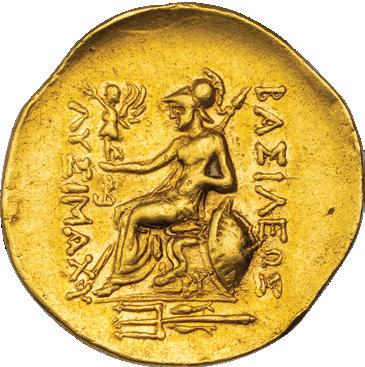

Athena enthroned left, holding Nike crowning Lysimachus’ name, control monogram in left field, BY on throne, ornate trident left in exergue. Marinescu Issue 87, 198 (O75/R191, noting 4 specimens); Müller 178.
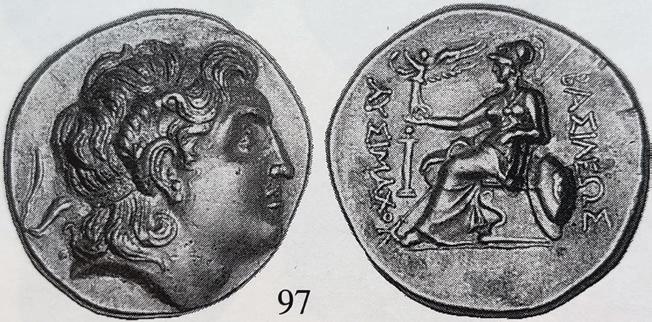
Ex Classical Numismatic Group 53, 3/15/2000, lot 281. NGC graded XF, Strike 4/5, Surface 3/5, “edge marks,” “die shift,” extremely rare variety, this is the sole specimen to appear on the market since Marinescu’s 1996 work.

11
ΛΥΣΙΜΑXΟΥ,
ΛΥΣΙΜΑΧΟΥ,
FROM THE NFA SALE OF 1993 AND PUBLISHED BY FISCHER-BOSSERT
15 (18676). KINGS OF MACEDON. PHILIP II. 359-336 BC.
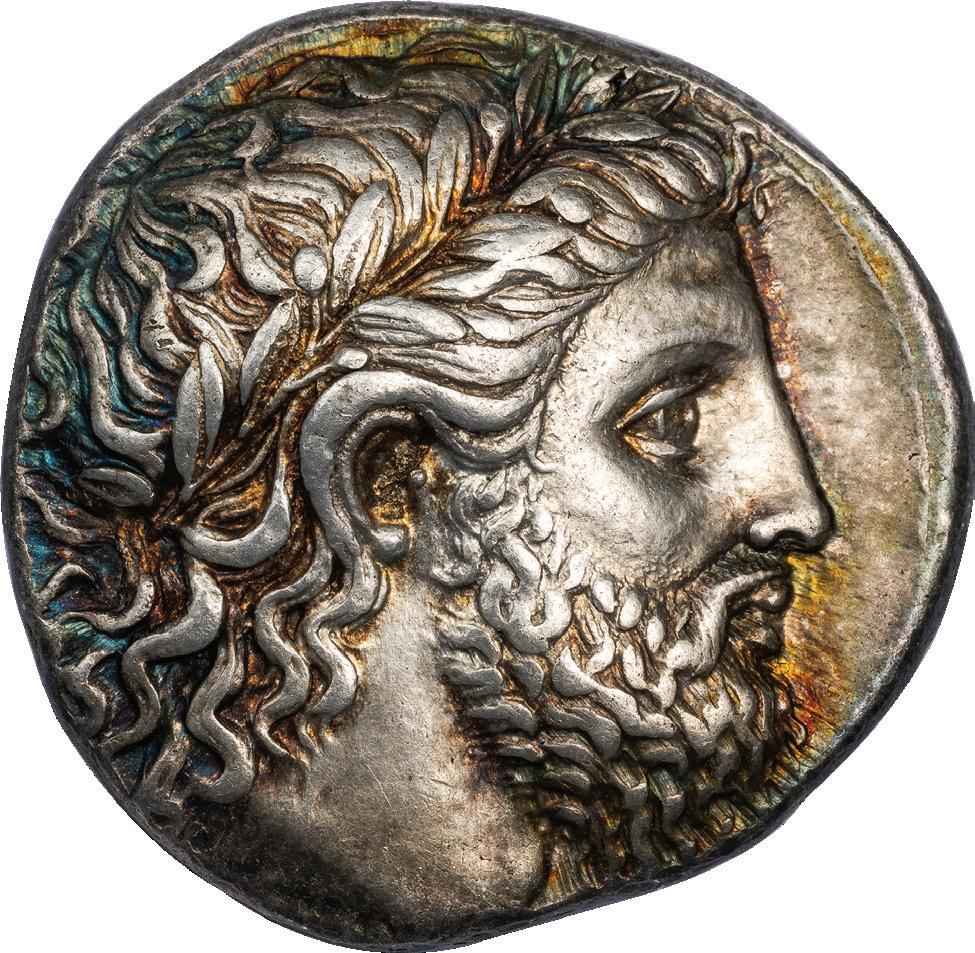


Silver tetradrachm, 14.50 g, 25 mm. Lifetime issue of Pella, ca. 348/7-343/2 BC.
Obv. Laureate head of Zeus right. Rev. ΦIΛIΠΠOY, youth on horseback right, wearing fillet, holding palm branch, the horse’s head also filleted.
Le Rider 166 (O 102/R 136); HGC 3.1, 862.
Ex The Century Collection, The New York Sale 57, 1/10/2023, lot 24 = Sotheby’s 12/2/1994, lot 15.
NGC graded AU STAR, Strike 5/5, Surface 4/5, FINE STYLE, boldly struck and of outstanding style, with a pale multicolored iridescence on the obverse.
The reverse type of this exceptionally well struck and beautifully engraved lifetime tetradrachm of Philip II is engagingly historic for the Greek coin collector. While the type depicting a youth on horseback serves as a visual pun on the king’s name, which literally means “Horse-lover,” it also refers to a specific event: the victory of Philip’s horse in the equestrian race held at the Olympic games of 356 BC. The victory is strongly emphasized on this coin, which, in addition to the palm branch in the rider’s hand, also represents him and his mount wearing the fillet of the victor. Not only was this victory at Olympia a boost to Philip’s prestige, but it was later thought to have foretold the many future victories that would be won through arms by his son, Alexander the Great, born on the same day as the Olympic victory in 356 BC.
The jockey tetradrachm type tetradrachms of Philip II circulated widely throughout the Macedonian kingdom and beyond its borders, including among the Thracian, Dacian and Celtic peoples who came into conflict with the king or served as mercenaries in his armies. Thanks to the prolonged use of these Philip-types, the local people continued to accept these coins long after the death of Philip in 336 BC. To meet this demand, the successors of Philip and Alexander the Great continued to produce them into the early third century BC. Even after these posthumous issues ceased, their types remained so popular as a sign of “good money” that they were frequently imitated in increasingly abstracted form by the Celtic peoples of eastern and central Europe.
16 (18501). KINGDOM OF MACEDON. PHILIP II, 359-336 BC.



Silver 1/5 tetradrachm, 2.51 g, 14 mm. Posthumous issue of Amphipolis III, ca. 343/2-ca. 316/5 BC.
Obv. Diademed head of Apollo right. Rev. ΦIΛIΠΠOY, nude rider right, laurel branch below horse.
Le Rider, p. 124, pl. 46.27.
Ex Salton Collection, likely acquired in the 1950s-1960s when Mr. Salton owned a numismatic firm in New York.
NGC graded CHOICE XF, Strike 5/5, Surface 3/5.
12
17 (18506). KINGDOM OF MACEDON. ALEXANDER III, THE GREAT, 336-323 BC.
Silver tetradrachm, 17.07 g, 25 mm. Posthumous issue of Babylon, ca. 310-301 B.C.
Obv. Head of young Heracles right in lion skin headdress. Rev.
Zeus enthroned left, holding eagle and scepter, astragalus above M in left field, monogram below throne.
Price 3674.
Ex Salton Collection, likely acquired in the 1950s-1960s when Mr. Salton owned a numismatic firm in New York.
NGC graded VF, Strike 5/5, Surface 4/5, dark gray patina.
ALEXANDER DRACHM FROM THE SALTON AND LOCKETT COLLECTIONS


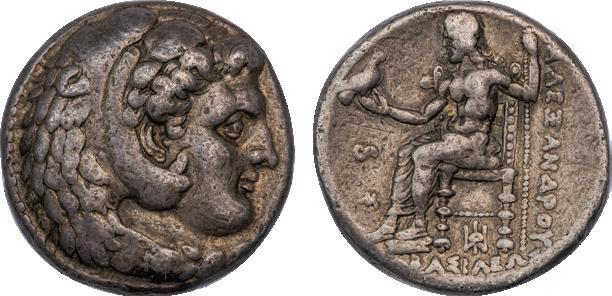
18 (18813). KINGDOM OF MACEDON. ALEXANDER III, THE GREAT, 336-323 BC.

Silver drachm, 4.29 g, 18 mm. Posthumous issue of Colophon, ca. 310-301 B.C.




Obv. Head of young Heracles right in lion skin headdress. Rev.
Zeus enthroned left, holding eagle and scepter, KΑΛ control monogram in left field, crescent below throne.
Price 1825; SNG Lockett 1487 (this coin listed and illustrated).
Ex Salton Collection; ex Richard Cyril Lockett Collection and published in SNG Lockett.
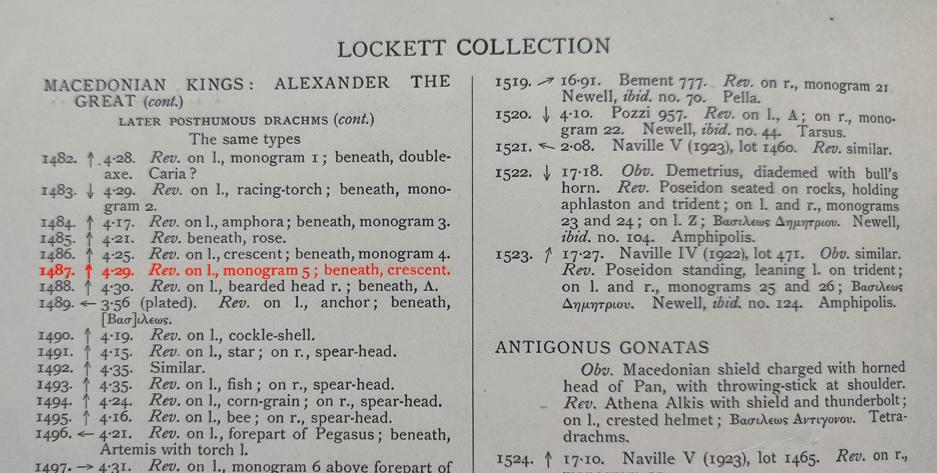
NGC graded CHOICE XF, dark gray patina.
19 (18515). ACARNANIA. ARGOS AMPHILOCHICUM. Ca. 350-300 BC.
Silver stater, 8.48 g, 20 mm.
Obv. Pegasus flying left, A below. Rev. [ΑΡ]ΓΕΙ, head of Athena wearing Corinthian helmet left, Corinthian helmet with long crest in right field.

Pegasi 11; HGC 4, 783; BCD Akarnania 132.
Ex Salton Collection, likely acquired in the 1950s-1960s when Mr. Salton owned a numismatic firm in New York.
NGC graded CHOICE VF, Strike 4/5, Surface 5/5.
Argos Amphilochicum in Acarnania was originally founded by a non-Greek people known as the Amphilochians. They were expelled from their city by the Ambraciots in ca. 440 BC but managed to reclaim it with the assistance of the Athenians and Acarnanians. The Ambraciots made further attempts to seize Argos Amphilochicum in 426 BC, but they were utterly defeated by the Amphilochians and their allies at the Battle of Olpae. According to Thucydides, the slaughter of the Ambraciots and their Spartan allies was the greatest calamity to take place in the Peloponnesian War before the Peace of Nicias (421 BC). In the aftermath, the Amphilochians immediately made peace with Ambracia out of fear that the total defeat of their old enemy would lead to a permanent Athenian presence in Acarnania.
13
ΒΑΣΙΛΕΩΣ
ΑΛΕΞΑΝΔΡΟΥ,
ΒΑΣΙΛΕΩΣ ΑΛΕΞΑΝΔΡΟΥ,
MARK SALTON NOTES THE LINK BETWEEN HIS EARLY AEGINA TURTLE AND THE FAMOUS TEMPLE OF APHAIA ON AEGINA

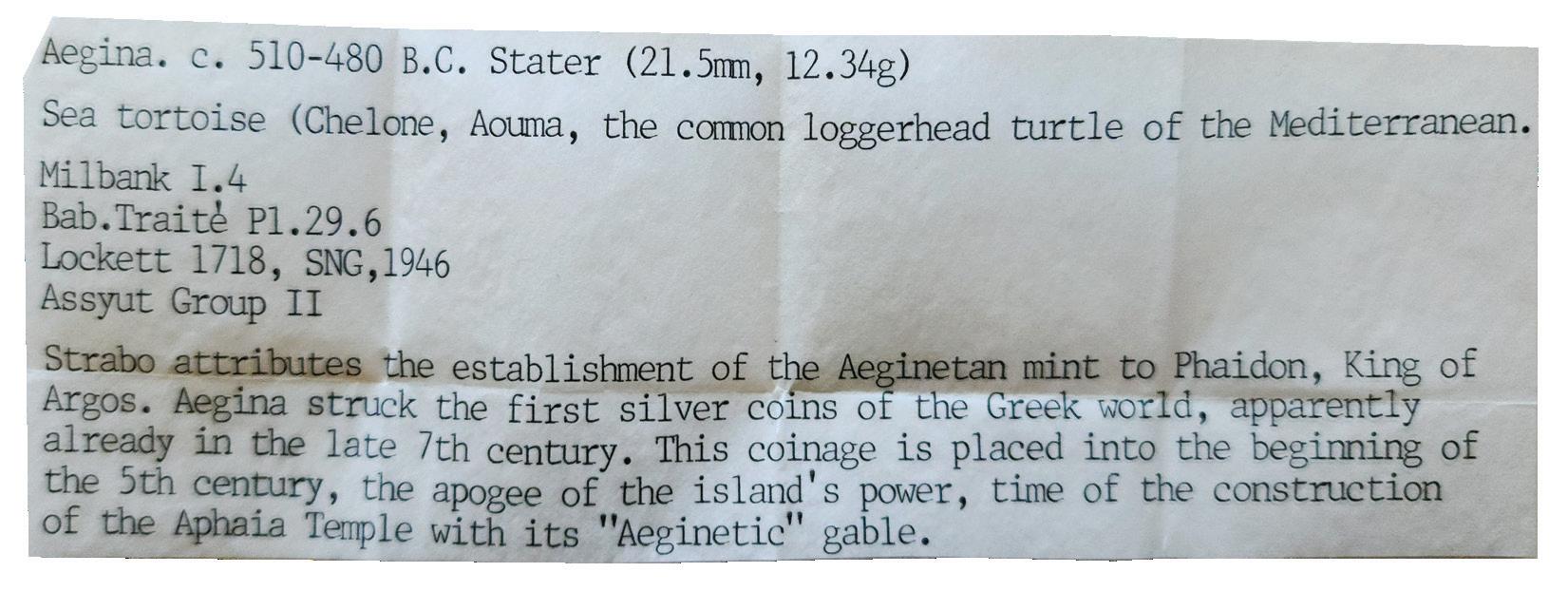
20 (18517). ISLAND OF AEGINA. Ca. 525-480 BC.
Silver stater, 12.35 g, 22 mm.
Obv. Sea turtle, its beaked head turned left, row of dots vertically along its shell, curved thin collar. Rev. Incuse square with “Union Jack” design.
HGC 6, 428; SNG Copenhagen 501-503; Boston MFA 1110.
Ex Salton Collection, likely acquired in the 1950s-1960s when Mr. Salton owned a numismatic firm in New York.
NGC graded CHOICE VF, Strike 4/5, Surface 4/5, perfectly centered turtle, the coin with a glossy old black cabinet patina that suggests a substantially older pedigree.
This stater features the famous obverse type that became so widely recognized in the Peloponnesus and the Aegean world in the sixth and early fifth centuries BC that they were colloquially known as “turtles.” Staters like this made a deep impact on the development of coinage in the Peloponnesus, where the Aeginetan standard dominated until the late fourth century BC. The lighter weight of the socalled symmachic standard of the Achaean League used for many later Peloponnesian coinages is thought to ultimately derive from the Aeginetan standard reduced by long wear.




Some Greeks believed the staters of Aegina to have been the first silver coins ever struck. According to both the historian Ephorus of Cyme and to the Parian Chronicle, the earliest Greek silver coinage was produced at a mint located in the Temple of Aphaia on Aegina at the order of Pheidon, the famous seventh-century BC tyrant of Argos. However, it is clear that Ephorus and the Parians were somewhat mistaken in their attribution to Pheidon since the earliest series of Aeginetan turtle staters only dates to ca. 550 BC. Mark Salton makes reference to this older tradition in a small, typed description that accompanies his typical hand-written circular tag and brown envelope. In part it reads: “Strabo attributes the establishment of the Aeginetan mint to Phaidon, king of Argos. Aegina struck the first silver coins of the Greek world, apparently already in the late 7th century, the apogee of the island’s power, time of the construction of the Aphaia Temple with its ‘Aeginetic’ gable.”

14
AEGINA TORTOISE STATER FROM SALTON-SCHLESSINGER’S 1955 SALE AND SAID TO BE FROM THE VICOMTE DE SARTIEGES COLLECTION
21 (18518). ISLAND OF AEGINA. Ca. 445-430 BC.
Silver stater, 12.30 g, 22 mm. Issue of ca. 445/4-430 BC.
Obv. Tortoise with segmented shell with dotted rim and scaly flippers. Rev. Incuse square with “skew” design.
HGC 6, 437; SNG Copenhagen 517; SNG Lockett 1988; Boston MFA 116.
Ex Salton Collection, from the Salton-Schlessinger Mail Auction Sale XXII, 2/28/1955, lot 213, there stated to be from the Vicomte de Sartiges collection, the same information also related on Salton’s circular tag that accompanies the coin. Although this stater is unlisted in Longuet’s Collection du Vicomte de Sartiges: séries Grecque et Romaine en 1910 ainsi que les acquistions depuis cette date, it is likely that Salton or previous dealers acquired the coin from Sartiges at a subsequent date.

NGC graded VF, Strike 4/5, Surface 4/5.
22 (18519). ISLAND OF AEGINA. Ca. 350-338 BC.

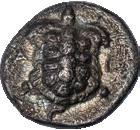

Silver obol, 0.84 g, 11 mm.
Obv. Tortoise with segmented shell with square ornamentation within, A-I in field. Rev. N-I within square incuse with skew pattern. HGC 6, 452; SNG Lockett 2012.
Ex Salton Collection, likely acquired in the 1950s-1960s when Mr. Salton owned a numismatic firm in New York.

NGC graded CHOICE XF, Strike 5/5, Surface 3/5, dark patina with iridescent highlights, light surface weathering.
In contrast with the earlier silver coinages of Aegina, which feature a sea turtle (see catalogue 20 above), later issues like the present coins depict a land tortoise on the obverse. It has been suggested that this iconographic change, which took place around in the mid-fifth century, was indicative of the change in the city’s fortunes. Whereas once Aegina had been an important hub for Peloponnesian and maritime trade, this came to an end ca. 445 BC, when the Athenians conquered the island and expelled its inhabitants. Ironically, by the time this obol was struck in the fourth century BC, the Aeginetans had been restored to their island and Aegina was being used as a Macedonian base for harassing Athens.

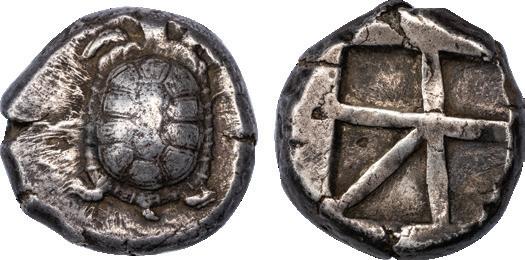
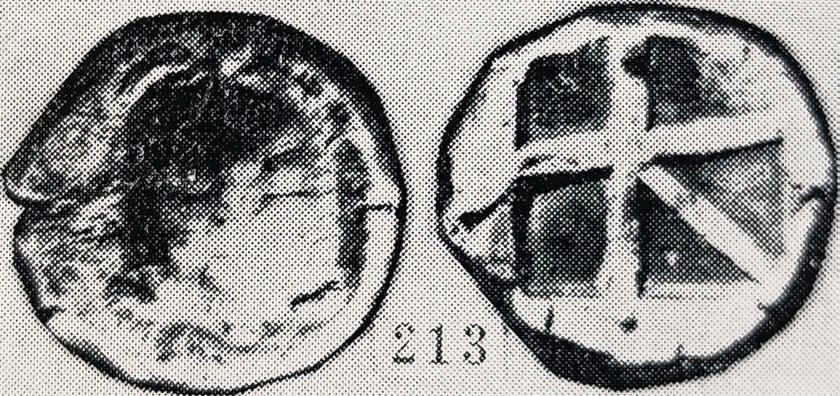

15
23 (18522). CORINTHIA. CORINTH. 4th CENTURY BC.
Silver stater, 8.44 g, 22 mm.
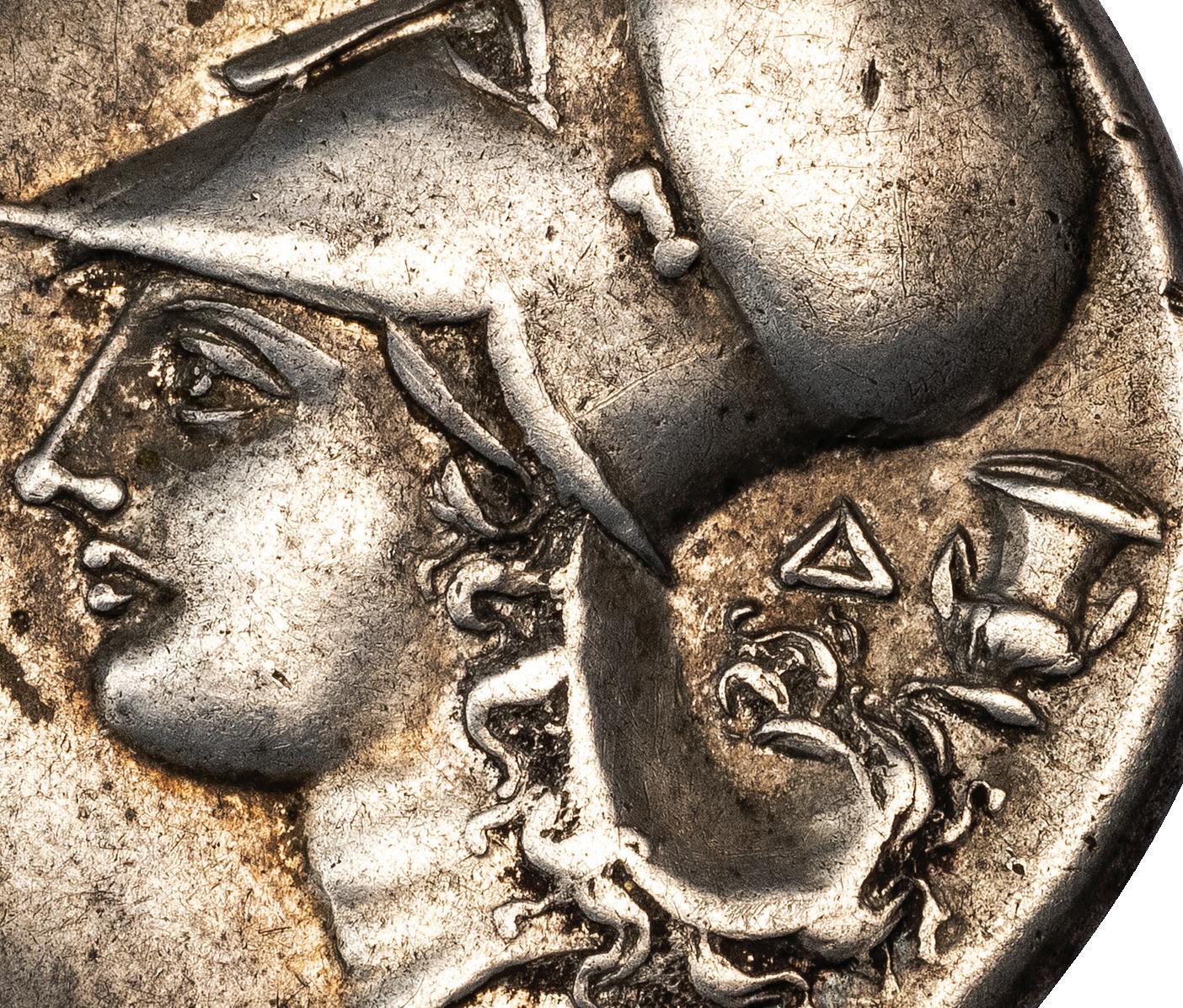
Obv. Pegasus flying left, koppa below. Rev. Head of Athena left, wearing Corinthian helmet, Δ and krater in right field.
Pegasi 388; HGC 4, 1848.
Ex Salton Collection, likely acquired in the 1950s-1960s when Mr. Salton owned a numismatic firm in New York.
NGC graded CHOICE VF, Strike 5/5, Surface 5/5, with a particularly interesting and rare symbol.
This coin is an attractive example of the “colt” coinage for which Corinth was famous throughout the Greek world. This popular name was derived from the depiction of Pegasus on the obverse. The flying horse became a civic badge of Corinth due to the mythological tradition in which Pegasus was tamed by the Corinthian hero Bellerophon when the horse alighted on the acropolis of Corinth to drink from the spring of Pirene. Pegasus went on to carry Bellerophon to victory over the monstrous Chimera before throwing the hero to his death during a hubristic ascent of Mount Olympus.


24 (18525). CORINTHIA. CORINTH. 4th CENTURY BC.
Silver stater, 8.59 g, 22 mm.
Obv. Pegasus flying left, koppa below. Rev. Head of Athena left, wearing Corinthian helmet with wreath, A below chin, eagle in right field, P in exergue.

Pegasi 426; HGC 4, 1848.
Ex Salton Collection, likely acquired in the 1950s-1960s when Mr. Salton owned a numismatic firm in New York.
NGC graded CHOICE VF, Strike 4/5, Surface 5/5, matte gray cabinet patina.
This second example of a Corinthian “colt” belongs to the same period as the preceding piece, the second half of the fourth century BC. Both coins may have been struck as pay for northwestern Greek mercenaries serving in the armies of Philip II, Alexander the Great, and their immediate successors. Such mercenaries traditionally expected payment with coins of the Corinthian weight standard and featuring the long-established types of the city.
16
cat. no. 23
cat. no. 24
25 (18745). CRETE. CYDONIA. Ca. 450-330 BC.
Silver hemidrachm, 2.69 g, 14 mm.

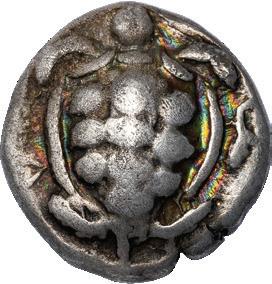
Obv. Tortoise with segmented shell, A in left field, KA monogram in right field. Rev. Incuse square with skew design and crescent within.
E.S.G. Robinson, “Pseudaeginetica,” NC (1928), 8; SNG Copenhagen 402; Le Rider, pl. xxviii, 8; CNG Triton XXIII, 1/14/2020, lot 280 (same dies, realized $ 10,000 hammer); Nomos 16, 5/10/2018, lot 112 (same dies, realized 8,000 CHF hammer).
Ex Hirsch 175, 9/23/1992, lot 288.
NGC graded CHOICE VF, Strike 4/5, Surface 3/5, with attractive multicolored iridescence.
26 (18700). SICYONIA. SICYON. Ca. 350-340 BC.
Silver stater, 12.24 g, 23 mm.
Obv. ΣE, Chimera advancing left, with right paw raised; wreath above. Rev. Dove flying right; A - Θ above and below tail; all within olive wreath.
BCD Pelponnesos I, 215 (this coin); MFA 1179 (these dies); HGC 5, 197.

Ex William Warden, 2023; ex NAC 133, 11/21/2022, lot 92 = Roma Numismatics 2, 10/2/2011, lot 204 = Stack’s 2011 International Sale, 1/10/2011, lot 78 = CNG 78, 5/14/2008, lot 683 = BCD Collection, LHS Numismatik 96, 5/8/2006, lot 21 = Leu Numismatik 81, 5/16/2001, lot 218 = Olga Knoepke Collection, Glendining 12/10/1986, lot 213.
Good VF, with iridescent toning around devices.
The chimera staters of Sicyon were an extremely important currency in the Peloponnesus in the late fifth and fourth centuries BC. Coins of this type were used to finance Sparta and her allies against Athens in the Peloponnesian War (431-404 BC) and against the rising power of Boeotian Thebes in the 370s and 360s BC. They were also the preferred coins for hiring mercenaries in the Peloponnesus during the expansion of Macedonian power in Greece in the 340s and 330s BC. This specimen, whose natural beauty is highlighted by exquisite iridescent toning, belongs to the tense period leading up to the showdown between Philip II of Macedon and an alliance of Greek states led by Athens and Thebes. Macedonian supremacy in Greece became assured after the crushing defeat of the allies at the battle of Chaeronea in 338 BC.





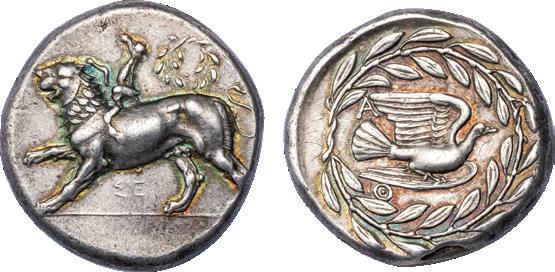
17
27 (18746). MYSIA. CYZICUS. Ca. 500-450 BC.






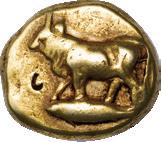
Electrum hecte, 2.59 g, 12 mm.
Obv. Bull striding left, tunny left below. Rev. Quadripartite incuse square. Von Fritze, Kyzikus, 88, SNG BN 224.
Ex Jonathan Rosen Collection, Münzen & Medaillen A.G. Basel, 10/6/1987, lot 207.
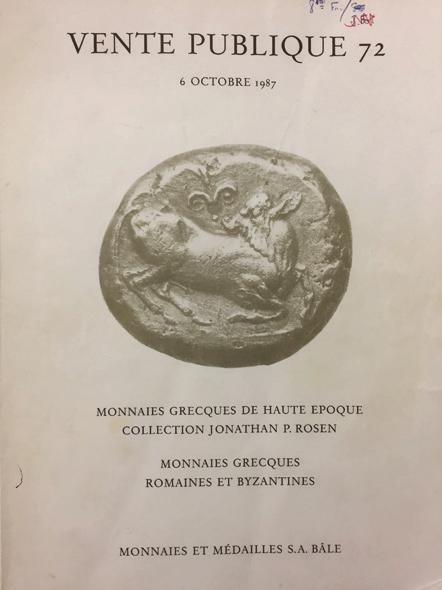
NGC graded CHOICE FINE, Strike 5/2, Surface 2/5, “countermark,” (crescent shaped banker’s mark on the obverse) and “punch mark” (on reverse) noted.
28 (18794). LESBOS. MYTILENE. Ca. 377-326 BC.
Electrum hecte, 2.56 g, 11 mm.
Obv. Head of Hermes right, wearing petasos. Rev. Panther right within square frame. Bodensted, 83; SNG von Aulock 1724; SNG Copenhagen 313; Weber 5618.

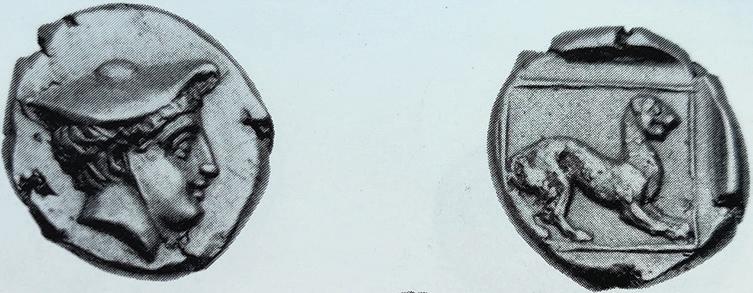
Ex American Private Collection, acquired from Vilmar Numismatics in 2015; ex Lanz 159, 12/8/2014, lot 228 = NFA XXII, 6/22/1989, lot 305.

NGC graded CHOICE AU, Strike 5/5, Surface 4/5, FINE STYLE, a beautiful coin struck in high relief.
29 (18747). IONIA. PHOCAEA. Ca. 625-522 BC.
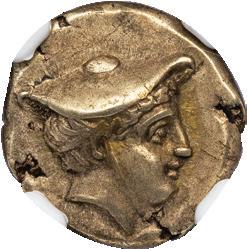
Electrum Hecte, 2.60 g, 10 mm.
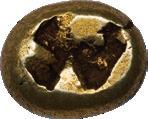

Obv. Head of roaring lion right, seal behind (partially off planchet). Rev. Quadripartite incuse square. Bodenstedt, 11.
Ex Gorny & Mosch Giessener Münzhandlung 138, 3/7/2005, lot 1407.
NGC graded XF, Strike 4/5, Surface 4/5.
18
30 (18462). CARIA. CNIDUS. Ca. 500-450 BC.
Silver drachm, 6.24 g, 18 mm.


Obv. Head of lion right. Rev. Head of Aphrodite right within incuse square. Cahn, Knidos. Die Münzen des Sechsten und des Fünften Jahrhunderts v. Chr. (Berlin, 1970), Series III, 64.2 (O31/R48, this coin listed, the reverse illustrated on pl. 15); HN Online 301.


Ex CNG Triton XXVI, 1/10/2023, lot 283 = Roma Numismatics XXV, 9/22/2022, lot 428 = Tauler & Fau 107, 3/30/2022, lot 1006 = Numismatik Naumann 113, 2/6/2022, lot 385 = Jolimont Collection, Leu Numismatik 10, 10/24/2021, lot 2173 = Münzen & Medaillen GmbH 38, 6/5/2013, lot 46 = Münzhandlung Basel private treaty 5/3/1938 = “Cabinet Numismatique du Prince W., etc,” Münzhandlung Basel 4, 10/1/1935, lot 824.
NGC graded XF, Strike 5/5, surface 4/5, FINE STYLE, “lt.scratches,” struck from artistic dies and published by Cahn. The 1935 sale of Münzhandlung Basel was dedicated to the famous collection of Prince Waldeck; presumably this is one of the many Greek coins that came from him since none of the other properties featured in this sale included early Greek coins such as this piece.
FIRST SELEUCID ISSUE COMBINING A ROYAL PORTRAIT WITH APOLLO REVERSE


31 (18533). SELEUCID KINGDOM. ANTIOCHUS I, 281-261 BC.
Silver tetradrachm, 16.95 g, 28 mm. Issue of Seleucia on the Tigris.
Obv. Diademed head of Antiochus I right. Rev. ΒΑΣΙΛΕΩΣ ΑΝΤΙΟΧΟΥ, Apollo seated left on omphalos, holding arrow in right hand and resting left on grounded bow, ΠA control in outer left field, HP in outer right field. SC 378.3; ESM 140.
Ex Salton Collection, likely acquired in the 1950s-1960s when Mr. Salton owned a numismatic firm in New York. NGC graded XF, Strike 5/5, Surface 2/5, FINE STYLE noted, minor surface roughness, with an exceptionally well engraved portrait of the king.
Tetradrachms of this type struck at Seleucia on the Tigris are thought to be the very first to feature a Seleucid royal portrait on the obverse and Apollo seated on the omphalos and testing an arrow on the reverse. This typology was part of an attempt by Antiochus I to create a universal Apollo-based Seleucid dynastic image that would be recognizable to the disparate ethnic groups that made up the kingdom. The portrait/Apollo formula would remain the standard for all Seleucid silver tetradrachms down to the mid-second century BC.



19
DRACHM LIKELY EX PRINCE WALDECK AND PLATED BY CAHN
A CNIDIAN
ARTHUR HOUGHTON’S EXTREMELY RARE MOLOSSIAN HOUND BRONZE
PUBLISHED IN CSE AND CITED IN SC
32 (18569). SELEUCID KINGDOM. DEMETRIUS I, 162-150 BC.



Bronze AE21, 8.71 g, 21 mm. Issue of “Uncertain Mint 83, Probably in Northern Syria.” Obv. Head of Molossian hound left, wearing collar. Reverse: ΒΑΣΙΛΕΩΣ ΔΗΜΗΤΡΙΟΥ ΣΩΤΗΡΟΣ, bust of lynx right, monogram in exergue.
HGC 9, 827; SC 1662a (this coin cited); CSE 556 (this coin listed and illustrated); Paris, Cabinet des Medailles, inv. Luynes.3337 (4350-42) = E. Babelon, Les Rois de Syrie, d’Arménie, et de Commagène. Catalogue de monnaies grecques de la Bibliothèque Nationale (Paris, 1890), no. 739; another specimen of this type, struck from the same obverse die but in lower grade, was sold by Roma Numismatics XXII, 10/7/2021, lot 432.
Ex American collection; ex Arthur Houghton Collection, and published in CSE. EF, elegant reddish-brown patina with areas of dark green, professionally cleaned since its publication in CSE and now revealing much of the splendid detail that was obscured under a thick layer of encrustation at the time Arthur Houghton owned it. Extremely rare, one of three known with this control variety.
This extremely rare coin is from the first collection of Arthur Houghton, easily the most important Seleucid coin collection formed by a private individual in the twentieth century, after that of Edward T. Newell. The obverse features the head of a hound wearing a collar, while the reverse depicts its quarry - a lynx, although this animal type has sometimes been described as a lion-griffin or even a wild goat. The hound should not be mistaken for some kind of Seleucid family pet. It is a Molossian hound - a famous breed of hunting dogs that originated in Epirus and which was celebrated in antiquity for both its large size and its vicious character. It has been suggested that all modern mastiff breeds may ultimately descend from the ancient Molossian hound. Whatever the truth of this may be, the Molossian hound on this coin serves to encapsulate the role of hunting in Demetrius’ rise to power in Syria and in his overthrow.
Demetrius I had been sent to Rome at a young age as a hostage for the good behavior of his father, Seleucus IV Philopator. When he learned that his uncle, Antiochus IV Epiphanes, had died in 164 BC, Demetrius I petitioned the Senate for permission to take up the Seleucid kingship, but was denied. In 162 BC, after further requests were also denied, Demetrius I let it be widely known that he was going on a hunting trip with friends, and perhaps with a trusty Molossian hound or two, in southern Italy. However, once he was in the countryside, Demetrius I gave up the hunt and secretly made his way to Brundisium, sailing back to claim his Syrian kingdom. Unfortunately, after consolidating his power, Demetrius I made a series of political and military blunders that caused a coalition of disgruntled Attalid, Ptolemaic and Cappadocian kings to form against him and support the pretender Alexander I Balas in a bid for the throne. This would have been a serious enough problem for a popular Seleucid king, but Demetrius’ taste for hunting and aloofness from the people of Antioch meant that few rallied to his cause, or mourned his death, in the final battle with Alexander I Balas. Thanks to the alienation of his people, when the showdown with Alexander came in 150 BC, Demetrius I was no longer the ferocious houndlike the animal of the obverse. In his rush to power, he had been responsible for the execution of his cousin, Antiochus V Eupator, to seize the throne in 162 BC as well as the destruction of the eastern usurper, Timarchus, in 160 BC. But now the hunter had become the hunted and he was more akin to the lynx of the reverse - a fighting quarry, but one hopelessly outmatched by the huge number of dogs and hunters who ranged against it.
20

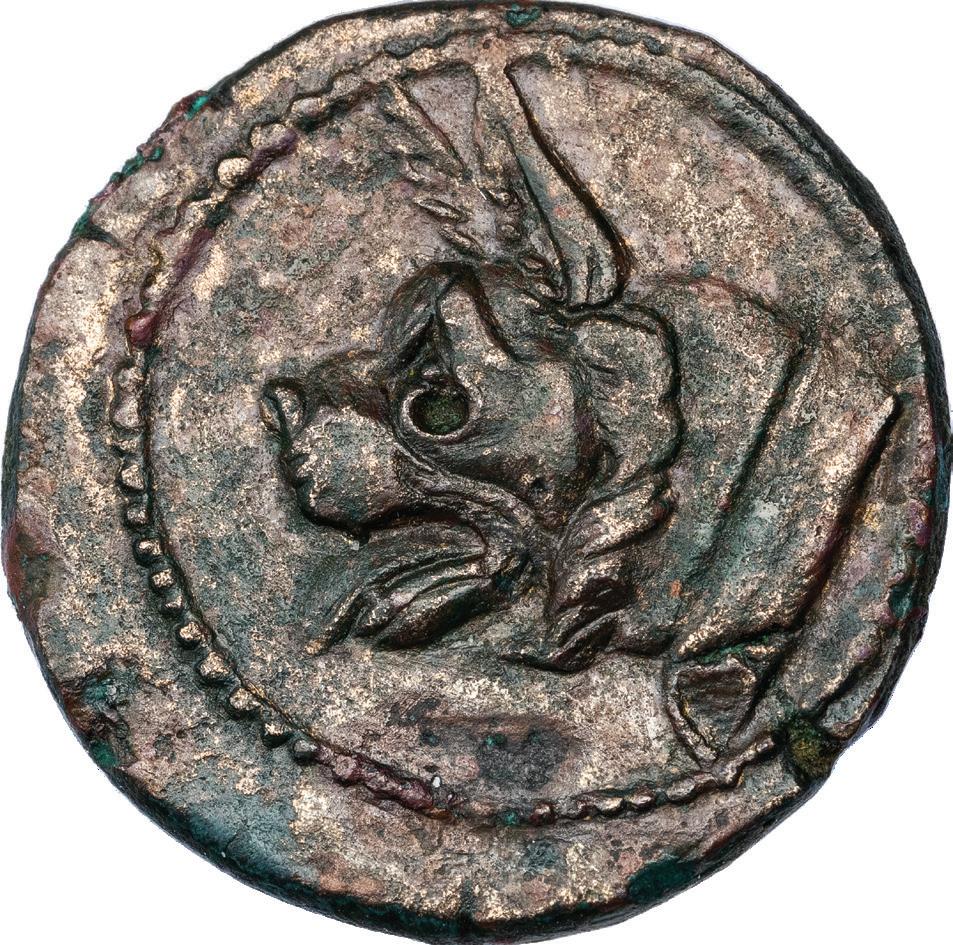

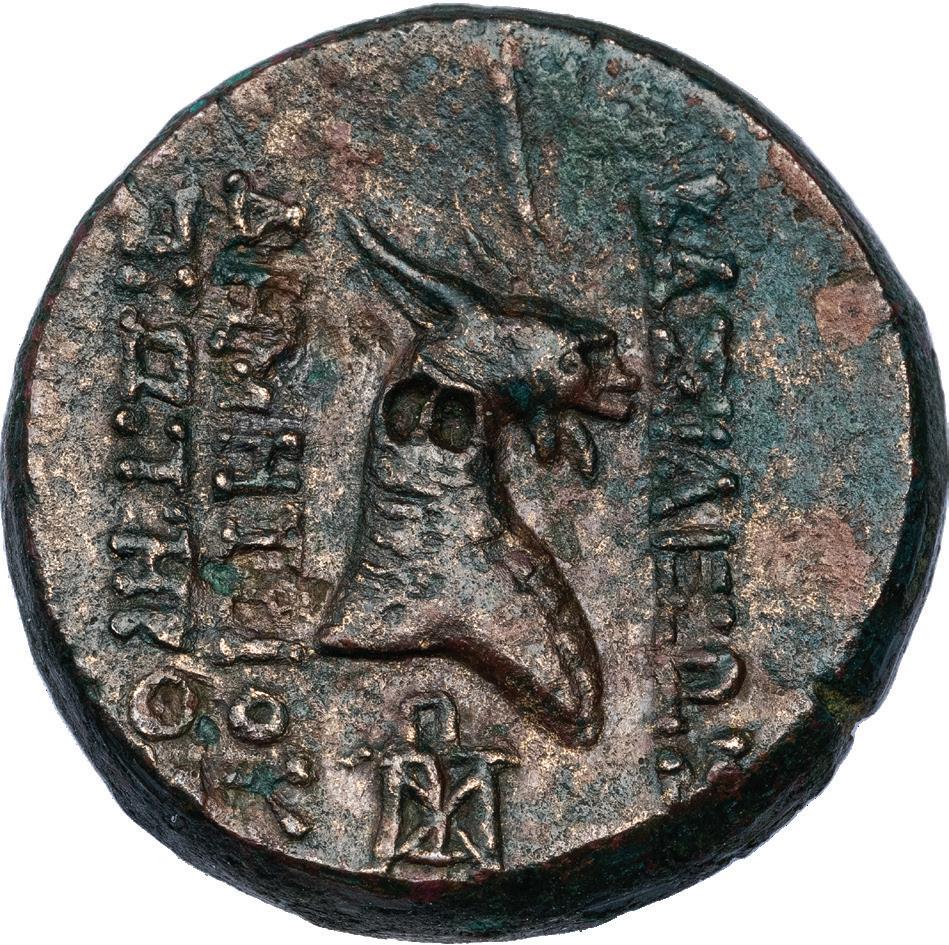

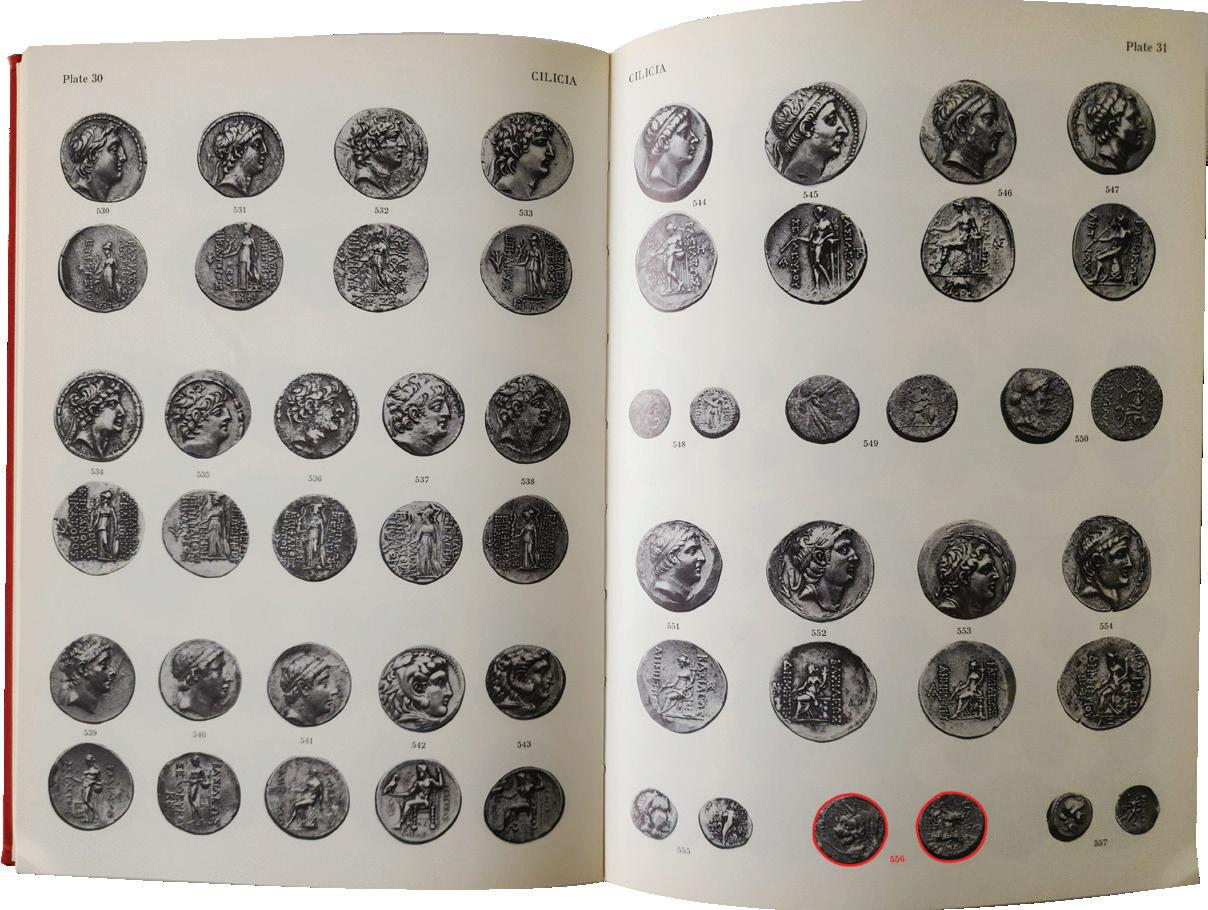
21
33 (18535). SELEUCID KINGDOM. ANTIOCHUS VIII, 125-96 BC. Silver tetradrachm, 16.10 g, 28 mm. Issue of Antioch on the Orontes, ca. 109-96 BC. Obv. Diademed head of Antiochus VIII right. Rev. BAΣIΛEΩΣ ANTIOXOY EΠIΦANOYΣ, Zeus Nicephorus standing left, P above A to outer left, ΛI control below throne, all within laurel wreath.
HGC 9, 1200; SC 2309.1b.
Ex Salton Collection, likely acquired in the 1950s-1960s when Mr. Salton owned a numismatic firm in New York. NGC graded CHOICE XF, glossy gray cabinet toning, area of encrustation on reverse.
The outer left field controls permit the dating of this and the following tetradrachm to the third and final reign of Antiochus VIII Grypus at Antioch on the Orontes. Tetradrachms like this were needed by the king to finance the conflict with his half-brother, Antiochus IX Cyzicenus, who had been responsible for Grypus being expelled twice from Antioch (in 113 and 111/10 BC).
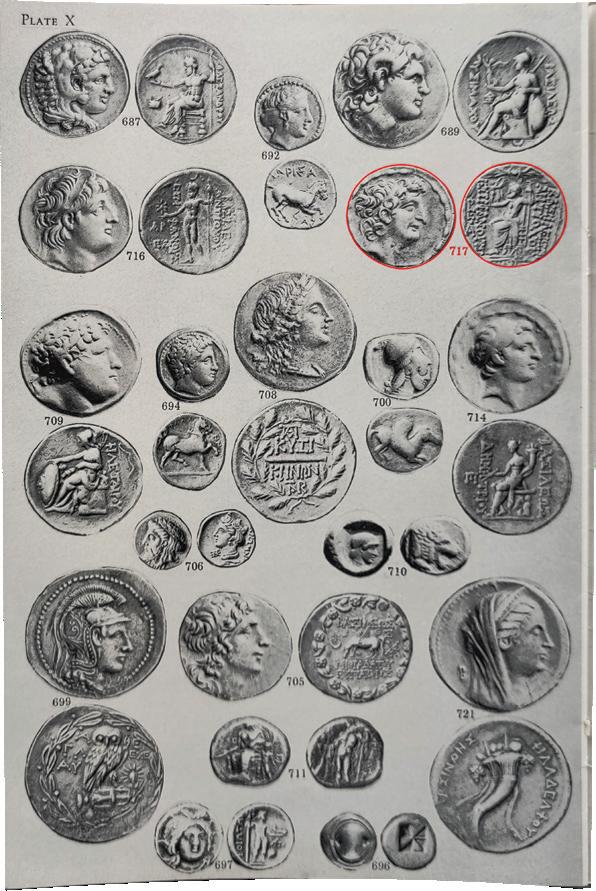
34 (18536). SELEUCID KINGDOM. ANTIOCHUS VIII, 125-96 BC.
Silver tetradrachm, 16.20 g, 27 mm. Issue of Antioch on the Orontes, ca. 109-96 BC.


Obv. Diademed head of Antiochus VIII right. Rev. BAΣIΛEΩΣ ANTIOXOY EΠIΦANOYΣ, Zeus Nicephorus standing left, P above A to outer left, ΛI control below throne, all within laurel wreath.
HGC 9, 1200; SC 2309.1d.
Ex Salton Collection, from the Salton-Schlessinger Mail Auction Sale XXIII, 11/22/1955, lot 717.

NGC graded XF, Surface 5/5, Strike 4/5, dark gray patina, with the photographs used by Salton to illustrate the coin in 1955.
Like the preceding tetradrachm, this piece belongs to the third and final reign of Antiochus VIII Grypus at Antioch on the Orontes. It is somewhat ironic that while he was producing this coinage to continue the struggle against Antiochus IX Cyzicenus, his own war minister, Heracleon, was plotting against him. In 96 BC, before Antiochus VIII ever got the opportunity to make new inroads against his half-brother’s possessions in the south, Heracleon had him murdered.

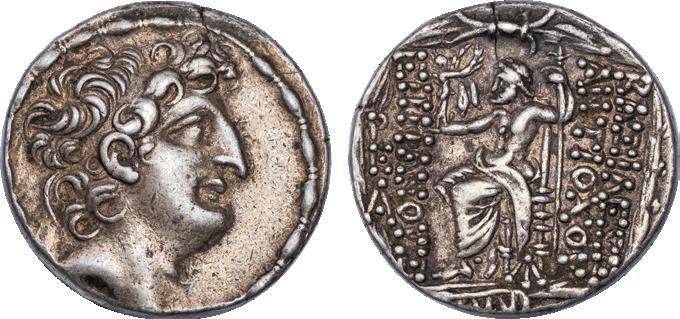
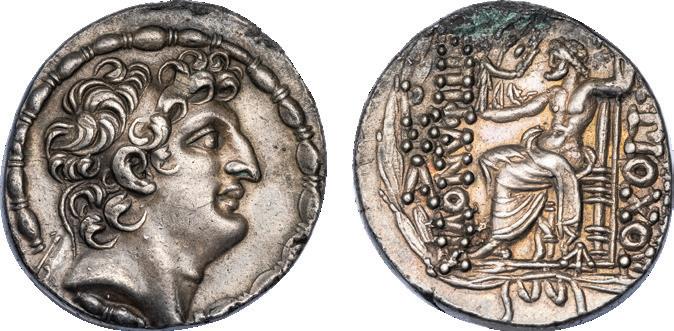
22
OVERSTRUCK TETRADRACHM OF SELEUCUS VI HELPFUL IN ESTABLISHING THE ORDER OF ISSUES FROM HIS REIGN
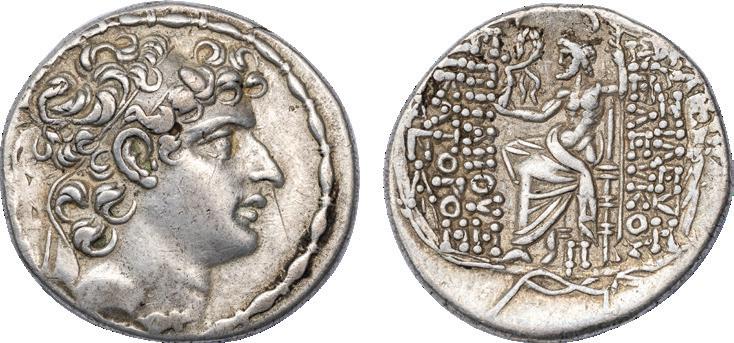
35 (18537). SELEUCID KINGDOM. SELEUCUS VI, ca. 96-94 BC. Silver tetradrachm, 16.03 g, 29 mm. Issue of Antioch on the Orontes, ca. 95/4 BC. Obv. Diademed and horned head of Seleucus VI right. Rev. BAΣIΛEΩΣ ΣEΛEΥKOY EΠIΦANOΥΣ NIKATOΡOΣ, Zeus Nicephorus standing left, A above monogram above A in outer left, Π below throne, all within laurel wreath.
HGC 9, 1270; SC 2415c.
Ex Salton Collection, likely acquired in the 1950s-1960s when Mr. Salton owned a numismatic firm in New York.
NGC graded CHOICE VF, “brushed.” Overstruck, with traces of the undertype behind the head and below the neck.

This coin is very interesting with respect to the sequence of tetradrachm emissions at Antioch on the Orontes under Seleucus VI. It is usually assumed that the tetradrachm series begins with emissions depicting the king with a beard (SC 2413), followed by issues depicting him beardless, but with the same outer left field controls (SC 2414.1), and ending with emissions depicting him beardless and with a small horn and new outer left field controls, as shown on the present issue. However, the compact and rounded form of the beads of the fillet border used for the tetradrachm on which this piece is overstruck indicates that the host coin was most likely an example of the bearded type. This suggests that the bearded and horned portrait was introduced much more closely following the bearded portrait issues than previously suspected.
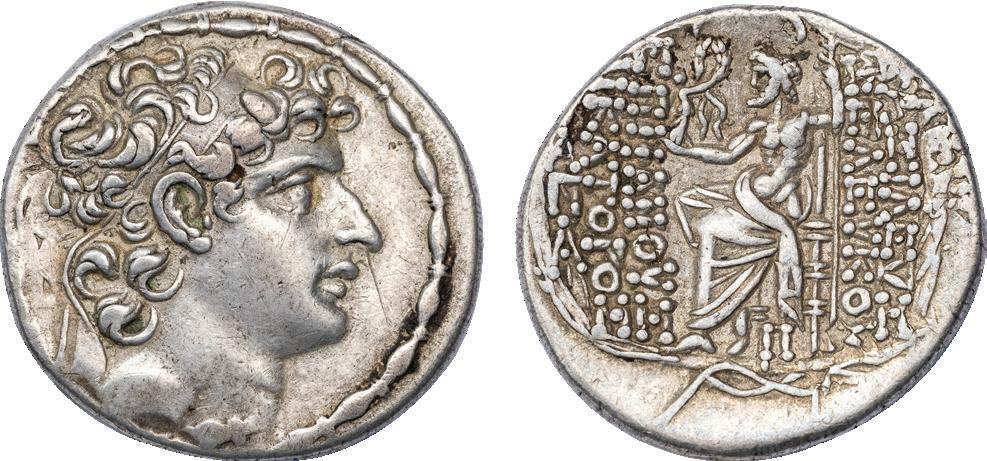
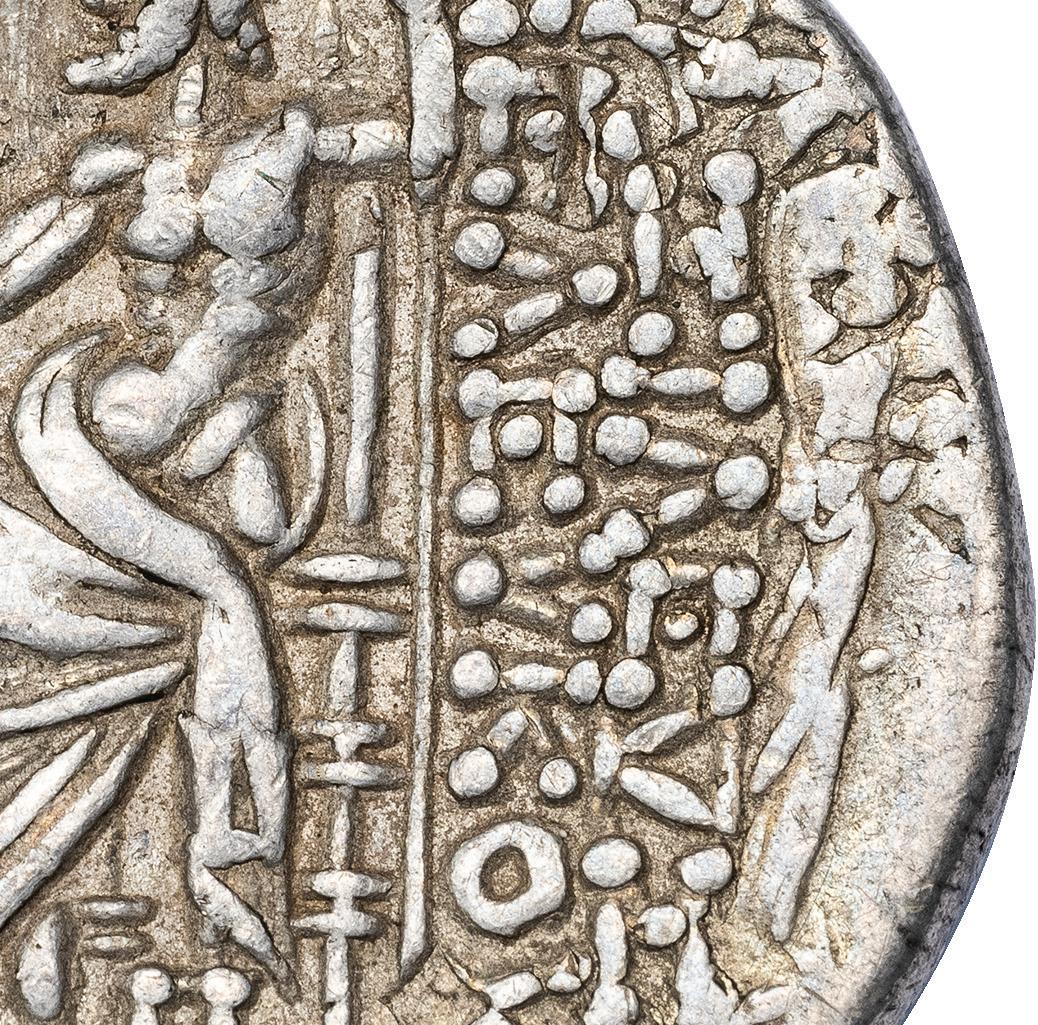
23
36 (18549). PHOENICIA. ARADUS, ca. 138/7-44/3 BC.
Silver tetradrachm, 15.36 g, 30 mm. Issue of Aradian Era year 131 (129/8 BC).
Obv. Veiled and turreted bust of Tyche right. Rev. APAΔIΩN, Nike standing left, holding aphlaston in right hand and palm branch in left; AΛP (date)/Λ/ΘN in left field; all within laurel wreath.


F. Duyrat, Arados hellénistique (Beirut, 2005), 3067 (this coin listed); HGC 10, 72.

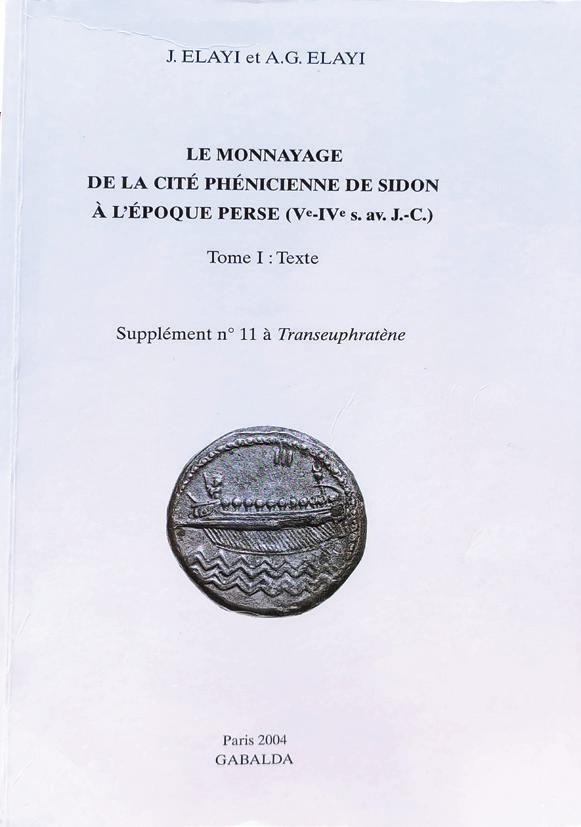
Ex Frankfurter Münzhandlung 156, 11/4/2022, lot 107; ex Poindessault, 6/18/1980, lot 201.
NGC graded CHOICE XF, Strike 5/5, Surface 4/5.
37 (18259). PHOENICIA. SIDON. MAZAEUS, ca. 361-328 BC.


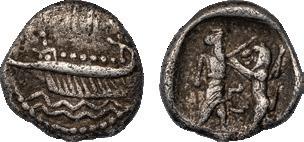
Silver 1/16 shekel, 0.73 g, 10 mm. Issue dated year 5 (349/8 BC).
Obv. Phoenician gallery left, sailing above stylized waves, Phoenician IIIII (date) above. Rev. Persian king standing right, facing fighting lion standing left, Phoenician letters between them.
Elayi & Elayi, Sidon, 2043 (this coin listed and illustrated).

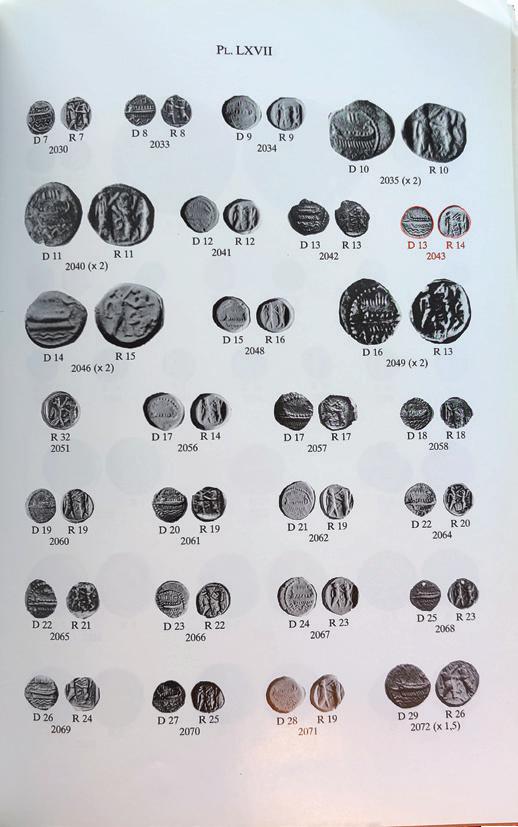

Ex Gert Cleff Collection, Wuppertal; ex Münzzentrum Albrecht & Hoffmann 71, 1991, lot 572.
NGC graded CHOICE VF, Strike 5/5, Surface 3/5.
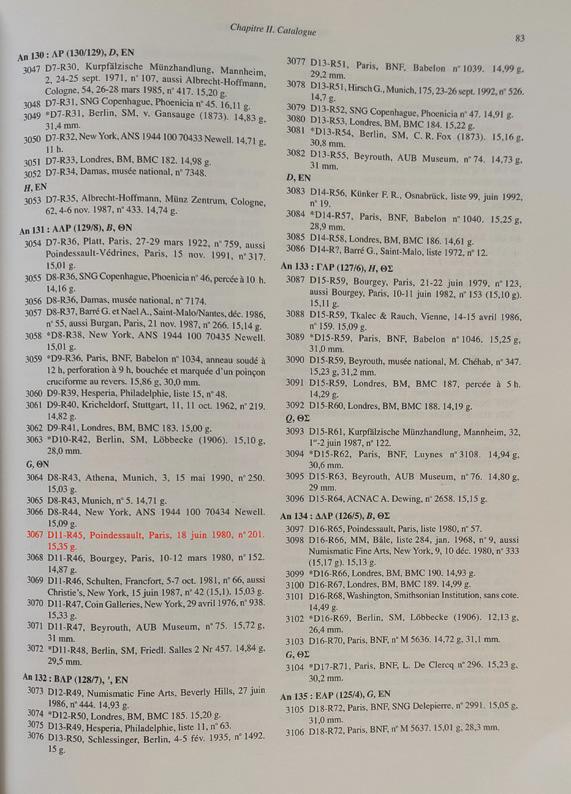
24
38 (18303). PHOENICIA. TYRE. AZEMILKOS, ca. 349-311/0 BC.
Silver didrachm (shekel), 8.49 g, 19 mm. Issue of year 9 (341/0 BC).
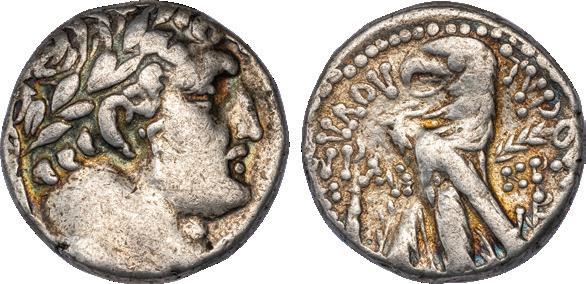
Obv. Melkart holding bow, riding hippocamp right above waves, dolphin right in exergue. Rev. Owl standing right, crook and flail behind, Phoenician inscription and date in right field.


Elayi & Elayi, Tyre, Group II.2.1.20, 1033 (O37/R51, this coin listed); HGC 10, 349.

Ex Lanz Numismatik 38, 11/24/1986, lot 414.
NGC graded CHOICE XF, 5/3, Surface 3/5, seldom encountered date.
CHRIST LIFETIME SHEKEL PLATED IN COHEN’S TYRE SUPPLEMENT

39 (18386). PHOENICIA. TYRE, 126/5 BC-AD 65/6.
Silver shekel, 13.84 g, 24 mm. Lifetime of Christ issue dated Tyre year 148 (AD 22/3).

Obv. Laureate head of Melkart right. Rev. ΤΥΡΟΥ ΙΕΡΑΣ ΚΑΙ ΑΣΥΛΟΥ, eagle standing left on prow, PMH (date) above club in left field, KP above MP? monogram in right field, no Phoenician letter between legs.

DCA Tyre Supplement Release 2, 535 (this coin listed and illustrated).
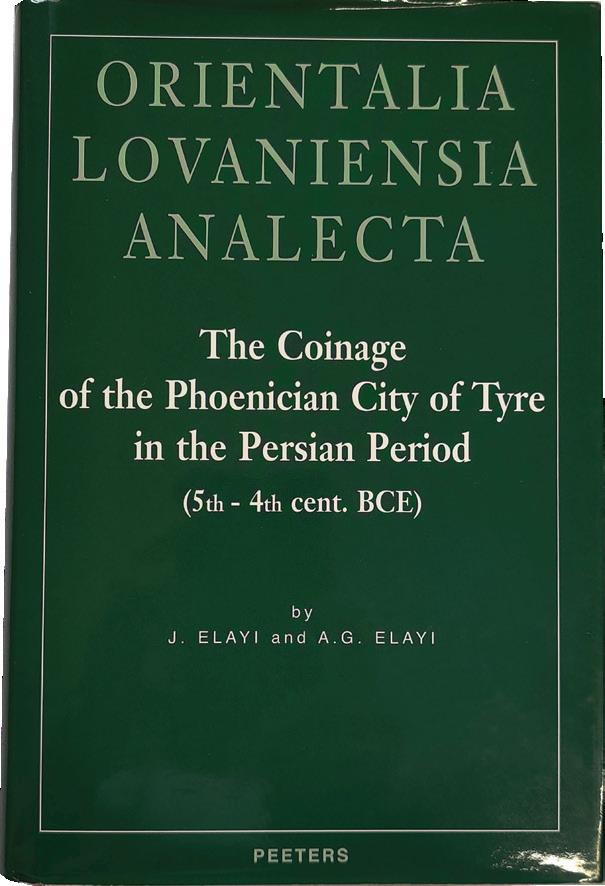
Ex CNG Electronic Auction 71, 8/20/2003, lot 19.
NGC graded CHOICE FINE, Strike 4/5, Surface 4/5, extremely rare date, with only a handful of specimens in market records.
25
40 (18543). JUDAEA. JEWISH WAR, 66-70 CE. Silver shekel, 13.43 g, 22.6 mm. Issue of Jerusalem, dated year 1 (66/67 CE). Obv. “Shekel of Israel, Year 1” (paleo-Hebrew), chalice with smooth rim, pellet on either side. Rev. “Jerusalem the Holy” (paleoHebrew), staff with three pomegranate buds. Hendin 6383; Deutsch 24 (O8/R18); TJC 187. Ex Michael Beall Collection, privately acquired from David Hendin via Herakles Numismatics, January 2016 (consignment document with Hendin collection pieces illustrated above); ex David Hendin Collection. NGC graded CHOICE XF, Strike 5/5, Surface 4/5.


Throughout history, some of the most tumultuous events have been set in motion by much smaller incidents and by the responses to them. The Jewish War fought against Rome from 66-70 CE, and which had a deep impact on the development of Jewish culture is just such an example. In the summer of 66 CE, a Greek merchant in a dispute with his Jewish neighbors in Caesarea caused offense by purposely sacrificing birds before the local synagogue, thus rendering it ritually unclean. When the Jews complained to Gessius Florus, the Roman procurator of Judaea, in the hope of retribution and protection against future offenses, they found themselves placed under arrest. The news of these events resulted in the suspension of traditional prayers and sacrifices on behalf of the emperor at the Jerusalem Temple as a sign of protest against the Roman administration. Florus, then compounded the growing discontent by forcibly taking 17 talents of silver from the Temple treasury, claiming the exaction was made to cover unpaid taxes. Rioting broke out in Jerusalem almost immediately as Jewish factions violently clashed with the Romans and with each other over the question of full armed revolt against Rome.
Due to the incompetence of Florus, the Roman governor of Syria, C. Cestius Gallus was compelled to march against Judaea to restore order by force. He advanced with little difficulty, but an ambush at Beth Horon left his army in tatters and unable to press the siege. The Battle of Beth Horon is considered the worst defeat ever inflicted on the Roman army by a rebel force.
In the aftermath of this great victory, and hopeful that the expulsion of the Romans from Judaea was at hand, a Jewish provisional government was formed in Jerusalem under the leadership of the moderate Pharisee and Sadducee priestly factions. The members of this new, free political entity immediately set about preparing Judaea for the major Roman military response that was sure to follow. To this end, work began to improve the fortifications of Jerusalem and military commanders were placed in charge of raising and training forces to defend Judaea and Galilee.
To finance all of this and to advertise the break with Rome, the provisional government used the silver in the Temple’s treasury to strike new coins of shekel and half shekel denominations with types that conformed to Jewish law and legends that consciously looked back to the days of King David by using paleo-Hebrew script. The date also proclaimed the beginning of a new era of freedom, which, alas, was only destined to last for a few years.


26
SILVER FROM THE TEMPLE TREASURY: YEAR 1 SHEKEL FROM THE COLLECTIONS OF MICHAEL BEALL AND DAVID HENDIN
41 (18699). JUDAEA. JEWISH WAR, 66-70 CE.
Silver shekel, 14.08 g, 23 mm. Issue of Jerusalem, dated year 2 (67/8 CE).
Obv. “Shekel of Israel; year 2” (paleo-Hebrew), chalice with rim of eight pearls. Rev. “Jerusalem the Holy” (paleo-Hebrew), staff with three pomegranate buds.

Hendin 6387; Deutsch 111 (O7’/R106); TJC 193 var (number of pearls on chalice rim).
NGC graded AU, Strike 5/5, Surface 3/5, “brushed”, “die shift,” attractively toned surfaces; this coin is a rare die pairing with Deutsch listing only 2 specimens.
A SPECTACULAR YEAR 2 HALF SHEKEL EX SOLOMON COLLECTION
42 (18675). JUDAEA. JEWISH WAR, 66-70 CE.
Silver half shekel, 6.74 g, 19 mm. Issue of Jerusalem, dated Year 2 (67/8 CE).




Obv. “Half of a shekel; year 2” (paleo-Hebrew), chalice with pearled rim. Rev. “Jerusalem the Holy” (paleo-Hebrew), staff with three pomegranate buds.


Hendin 6388; Deutsch 24 (O3/R23); TJC 195.
Ex Solomon Collection, Stack’s Bowers, 8/19/2019, lot 20025; ex Harlan J Berk 175, 7/7/2011, lot 166.
NGC graded AU, Strike 5/5 Surface 3/5, an exceptional example with exemplary matte surfaces that show a gentle rose iridescence.
The types used for the shekels and half shekels of the Jewish War have always been a subject of discussion. The chalice on the obverse has been variously identified as a drinking vessel, the kos used for collecting the blood of sacrifices, a generic chalice, or even the Temple laver used for ritual washing before entering the Temple. The most popular interpretation, however, is that the chalice on the coins represents the Omer Cup - a golden vessel used to contain the first fruits offered in the Temple on the second day of Passover (Leviticus 23: 9-11).The reverse type has sometimes been interpreted as the almond-wood rod of Aaron, which miraculously turned into a serpent when Moses cast it down before Pharaoh when he first demanded the freedom of the Israelites. It later sprouted buds as a sign that the tribe of Levi was to provide the priestly class and was subsequently carried within the Ark of the Covenant. More recent research suggests that it may be the staff of office carried by the high priest and that the buds are pomegranates. The pomegranate was a wellknown emblem of the Temple and the Jewish priesthood extending back to the days of the Kingdom of Judah.
27
RARE YEAR 2 SHEKEL DIE PAIRING
43 (18544). JUDAEA. BAR KOKHBA REVOLT, 132-135 CE. Silver sela (tetradrachm), 14.41 g, 24 mm. Issue dated year 2 (133/4 CE). Obv. “Simon” (paleo-Hebrew), facade of the Temple, ark with scrolls within; star ornament above. Rev. “Year two for the freedom of Israel” (paleo-Hebrew), lulav with etrog to left.
Hendin 6417 (this coin illustrated); TJC 233; Mildenberg 42 (O11/R29).







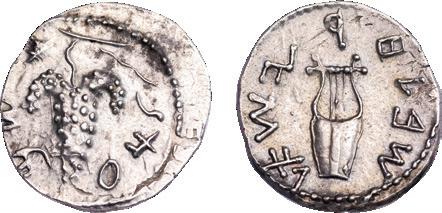
Ex David Hendin Collection; ex Classical Numismatic Group Electronic Auction 488, 3/24/2021, lot 270.
NGC graded CHOICE AU, Strike 3/5, Surface 5/5, “overstruck,” glossy dark gray toning with iridescent highlights, a coin plated in David Hendin’s latest edition of Guide to Biblical Coins.
The Bar Kokhba Revolt (ca. 132-135 CE) appears to have exploded in Judaea after Hadrian decided to rebuild the ruins of Jerusalem as the Roman colony of Aelia Capitolina, with the Jewish Temple now dedicated to Jupiter Optimus Maximus. Jewish rebels, led by the messianic figure of Simon Bar Kokhba, fought a long, bloody and ultimately disastrous war against the Romans that was financed by a new purely Jewish coinage. The new coins, which included silver denominations like the sela and zuz described here, were produced in emergency conditions by overstriking locally-circulating Roman imperial and Roman provincial coins.
FROM THE JAY GALST AND DAVID HENDIN COLLECTIONS
Obv. “Simon” (paleo-Hebrew), grape bunch hanging from a vine. Rev. “Year 2 - For the freedom of Israel” (in Paleo-Hebrew), lyre. Hendin 6425; TJC 242; Mildenberg 47 (O8/R27).
Ex Dr. Jay Galst Collection, privately acquired from David Hendin in December of 1989.
NGC graded AU, Strike 4/5, Surface 4/5, “overstruck,” some traces of the Roman undertype are visible.
28
JUDAEA. BAR KOKHBA REVOLT, 132-135 CE.
BAR KOKHBA YEAR 2 SELA PLATED IN HENDIN’S 6th EDITION OF BIBLICAL COINS
45 (18545). JUDAEA. BAR KOKHBA REVOLT, 132-135 CE.

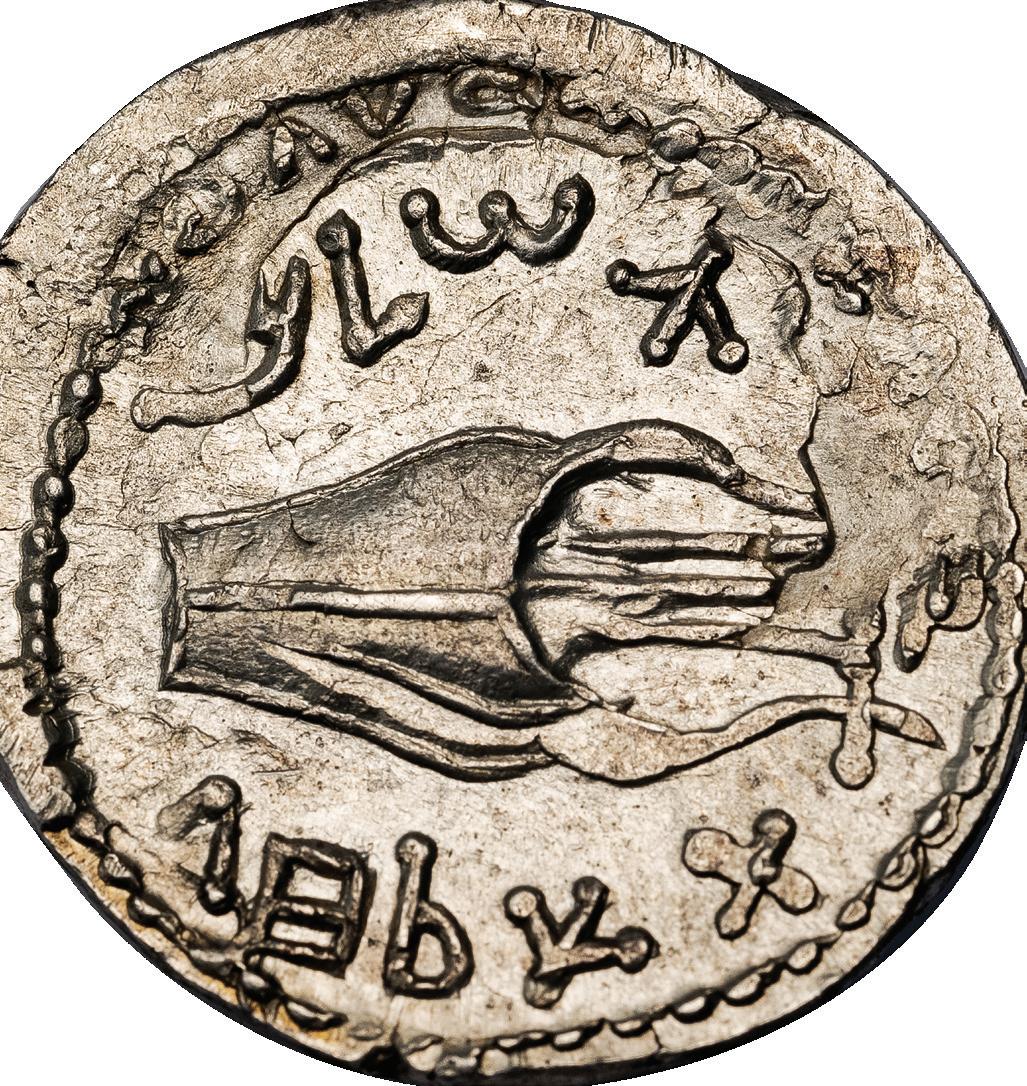


Silver sela (tetradrachm), 14.49 g, 25 mm. Issue of of year 3 (134/5 CE).
Obv. “Simon” (paleo-Hebrew), facade of the Temple, ark with scrolls within, star ornament above. Rev. “For the freedom of Jerusalem” (in Paleo-Hebrew), lulav with etrog in left field.
Hendin 6439; TJC 267; Mildenberg 71 (O15/R53).
Ex David Hendin Collection; ex Alan Levin Collection, Goldberg 41, 5/28/2007, lot 2613.
NGC graded CHOICE AU, Strike 4/5, Surface 4/5, “overstruck.”
OVERSTRUCK ON A DENARIUS OF TRAJAN

Silver zuz, 3.12 g, 20 mm. Undated issue of year 3 (134/5 CE), overstruck on a denarius of Trajan.

Obv. “Simon” (paleo-Hebrew), grape bunch hanging from a vine. Rev. “For the freedom of Jerusalem” (in Paleo-Hebrew), lyre.
NGC graded MINT STATE, Strike 3/5, Surface 4/5, “overstruck, “undertype:Trajan denarius.” The profile of Trajan is visible on the reverse, and remnants of the undertype legend on the obverse suggest that the overstruck coin was a denarius with trophy reverse, RIC
AND
EX DAVID HENDIN
ALAN LEVIN COLLECTIONS
FROM ADOLPH HESS’ 1907 SALE OF BERLIN MUSEUM DUPLICATES AND PUBLISHED BY
 OLIVIER & LORBER
OLIVIER & LORBER
47 (18753). EGYPT. PTOLEMAIC KINGDOM. ARSINOE II PHILADELPHUS, 277-270/268 BC.

Gold mnaieion (octadrachm), 27.71 g, 28 mm. Posthumous issue of Alexandria, struck under Ptolemy II, dated Year 20 (251/0 BC). Obv. Diademed and veiled head of deified Arsinoe II right, with horn of Ammon and wearing stephane; lotus-tipped scepter in background above head; K (date) behind. Rev. APΣINOHΣ ΦIΛAΔEΛΦOY, double cornucopia with grape bunches hanging at sides, bound with fillet.



CPE 390; Svoronos 475; J. Olivier and C. Lorber, “Three gold coinages of third-century Ptolemaic Egypt,” RBN CLIX (2013), no. 244, dies 1/20 (this coin listed); H. Troxell, “Arsinoe’s Non-Era” in ANSMN 28 (1983), Group 3, p. 44 and pl. 7, 3 (same obv. die); Boston
MFA 2268 (same obv. die); BMC 10 (same dies); Pozzi 3223 (same obv. die).


Ex CNG Triton XXI, 1/9/2018, lot 540; ex Berlin Museum Duplicates, Adolph Hess, 10/7/1907, lot 1468.
NGC graded CHOICE VF, Strike 5/5, Surface 3/5, an attractive octadrachm once in the collection of the Berlin Museum with over a century old pedigree.
30
ONE OF THREE KNOWN SPECIMENS OF SIDON YEAR 38 OCTODRACHMS

PUBLISHED IN TROXELL AND CITED IN LORBER’S “COINS OF THE PTOLEMAIC EMPIRE”

48 (18796). EGYPT. PTOLEMAIC KINGDOM. ARSINOE II PHILADELPHUS, 277-270/268 BC.
Gold mnaieion (octadrachm), 27.72 g, 29 mm. Posthumous issue of Sidon, struck under Ptolemy II, dated Year 38 (248/7 BC).


Obv. Veiled head of deified Arsinoe II right, with horn of Ammon and wearing stephane; lotus-tipped scepter in background above head. Rev. APΣINOHΣ ΦIΛAΔEΛΦOY, double cornucopia with grape bunches hanging at sides, bound with fillet; ΛH (date) in inner left field; ΣI above HΛ monogram below.
CPE 544 (this coin cited); Svoronos 754 (same dies); H. Troxell, “Arsinoe’s Non-Era” ANSMN 28 (1983), 52, no. 27 (this coin listed).

Ex Heritage CSNS Signature Sale 3107, 3/5/2023, lot 30031 = Stack’s 16/3/1983, lot 56 = NFA 6, 2/27/1979, lot 430.
NGC graded CHOICE AU, Strike 4/5, Surface 2/5, FINE STYLE, “edge filing,” extremely rare emission with only 3 specimens recorded by Troxell (nos. 25-27), including this one.
In 268 BC Ptolemy II deified his powerful and controversial sister-wife Arsinoe II, following her death. As part of her divine honors, she received a temple with her own priests in the Crocodilopolite nome, which was renamed the Arsinoite nome, and annual cult processions were held. Ptolemy II even reformed the Ptolemaic coinage system to celebrate the dead queen as a new goddess. As part of this reform, Ptolemy II introduced massive gold coins traditionally described as octadrachms, but which had the face value of a mina of silver (i.e., 100 drachms). They were struck at all major Ptolemaic mints in Egypt and Phoenicia, often with regnal year dates, but the Phoenician issues generally survive in lower numbers than those of Alexandria. The present issue of Sidon, dated to year 38 of Ptolemy’s reign (248/7 BC), is not only very beautiful, but also extremely rare. This variety was known to J. N. Svoronos from only a single specimen in 1904 and to Hyla Troxell from three in 1983, all of which employ the same dies and include this coin sold by NFA in 1979.
31
COLLECTION OF A BERLIN SURGEON
The following Roman coins were acquired from Vilmar Numismatics in 2012 by our Southern Collector. They formed part of a large collection amassed by a surgeon from Berlin active in the latter part of the nineteenth century and augmented by his descendants (“Generationensammlung”). These coins were sold at Hirsch 279, 2/8/2012. The main part of the collection was formed by the surgeon who served as the personal physician of Prince Charles of Prussia, and while in this capacity he traveled several times to Italy where he became fascinated by ancient numismatics. He began to collect in the 1870s and continued to do so until his death in 1895. His family passed down the collection and sporadically added to the holdings. The last of these collectors was married to the granddaughter of the surgeon. At the Hirsch sale the coins that were part of the 19th century “core” collection were clearly marked as having been “acquired prior to 1895,” while others noted as having more recent pedigrees were acquisitions by the doctor’s descendants. We are reporting the provenance as related in the Hirsch sale catalogue.
SEXTUS POMPEIUS FOSTLUS AND THE FOUNDATION STORY OF ROME
49 (18826). ROMAN REPUBLIC. SEX. POMPEIUS FOSTLUS, 137 BC. Silver denarius, 3.93 g, 21 mm.

Obv. Helmeted head of Roma right, X in right field, jug in left field. Rev. FOSTLVS SEX P[O], Faustulus the shepherd looking at the she-wolf suckling Romulus and Remus, tree with bird in the background, ROMA in exergue. Crawford 235/1; Sydenham 461.
Ex Southern Collector, ex Hirsch 279, lot 2153 = Gorny & Mosch Giessener Münzhandlung 22, 5/25/1982, lot 303. XF, golden iridescent highlights.

The reverse of this coin serves as a punning reference to the cognomen of the moneyer, Fostlus. It depicts the similarly named shepherd, Faustulus, who famously discovered the twins Romulus and Remus being suckled by the she-wolf after they had been exposed on the banks of the Tiber. Faustulus adopted the twins as his own and they grew up to be shepherds, without knowing their true identity as the sons of Mars and Rhea Silvia. Only when they had grown and became involved in the internal conflicts at Alba Longa, did the twins learn their true identities and set out to become the founders of Rome. The two birds in the tree behind the she-wolf also continue the theme of Roman origins. These birds are probably intended to represent Picus, the first king of Latium, and his wife Pomona. Both were cursed by the sorceress Circe and transformed into birds - Picus became a woodpecker, Pomona a magpie. According to some versions of the myth of Romulus and Remus, a woodpecker and other birds assisted the she-wolf in feeding the twins.




32
50 (18832). ROMAN REPUBLIC. ANONYMOUS, 115-114 BC.

Silver denarius, 3.75 g, 20 mm. Issue of Rome.
Obv. Head of Roma right, X in left field. Rev. Roma seated right on shield, leaning on lance, she-wolf with Romulus and Remus at right, birds flying above.
Crawford 287/1; Sydenham 530.
VF, nicely toned.
Ex Southern Collector; ex Berlin Surgeon, Hirsch 279, lot 2025, “acquired before 1895.”
The reverse type of this denarius is a symbolic shorthand for the story of the foundation of Rome. The personification of Roma - represented as an armed Amazon wearing a Phrygian helmet and seated on the arms of her enemies - appears in the center, while to her right are the exposed twins Romulus and Remus being suckled by the she-wolf. It was only through their survival and eventual adoption by the shepherd Faustulus that Rome was ultimately founded on the banks of the Tiber. The two birds that fly to the left and right of Roma refer to the use of augury to decide on the site of the city. According to Roman tradition, Romulus and Remus disagreed on the location of their city, with Romulus preferring a settlement on the Palatine Hill and Remus on the Aventine Hill. To solve the argument, the brothers agreed to an augury contest. Unfortunately, when Romulus claimed victory by noting the flight of 12 auspicious birds, Remus insulted his foundation on the Palatine and in a fit of rage, Romulus killed him. The original settlement of Rome was duly centered on the Palatine Hill.

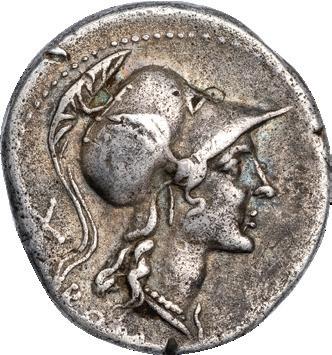



51 (18824). ROMAN REPUBLIC. MAN. AEMILIUS LEPIDUS, 114-113 BC.
Silver Denarius, 3.83 g, 18 mm. Issue of Rome.
Obv. ROMA, head of goddess right, X in left field. Rev. MN AE[MI]LIO, equestrian statue right on the attic of a three-bay arch labeled L-E-P.
Crawford 291/1; Sydenham, 554. Ex Southern Collector; ex Berlin Surgeon, Hirsch 279, lot 2030, “acquired before 1895.” VF.
The correct identification of the monument on the reverse of this denarius has long been controversial among scholars. It has been variously described as the Pons Aemilius (the oldest stone bridge in Rome, whose arches were constructed by P. Cornelius Scipio Africanus Aemilius and L. Mummius in 142 BC), a triumphal arch, or as the arches of the Aqua Marcia aqueduct across the Pons Aemilius. This extension began construction when M. Aemilius Lepidus and M. Fulvius Nobilior were censors in 179 BC but was only completed and named after Q. Marcius Rex in 144 BC, despite the opposition of another member of the gens Aemilii named M. Aemilius Lepidus. Comparison of the monument on this denarius with representations of bridges and aqueducts on Augustan issues has led to the conclusion that the arched structure here is most likely the aqueduct that extended the Aqua Marcia across the Pons Aemilius. It is used here by Manius Aemilius Lepidus to refer to the deed of his ancestor and perhaps as a slight against the gens Marcii for usurping the name of the aqueduct. It remains uncertain as to which goddess is depicted on the obverse and who the equestrian statue atop the aqueduct is intended to honor on the reverse.
33
AENEAS AND THE FOUNDATION OF ALBA LONGA
52 (18827). ROMAN REPUBLIC. C. SULPICIUS GALBA, 106 BC. Silver serrate denarius, 3.86 g, 21 mm. Issue of Rome. Obv. D P P, conjoined laureate head of the Penates left. Rev. C SVLPICI C F, two soldiers pointing toward a sow between them. Crawford 312/1; Sydenham 572. Ex Southern Collector; ex Berlin Surgeon, Hirsch 279, lot 2186, “acquired before 1895.” Near XF, sharply detailed strike.



Gaius Sulpicius Galba, the moneyer responsible for this coin, was a Republican ancestor of Servius Sulpicius Galba, who reigned briefly as emperor (8 June AD 68-15 January AD 69) during the infamous “Year of the Four Emperors.” The obverse depicting the Dei Penates Publici (the household gods responsible for protecting the provisions of the Roman state) and the reverse depicting two soldiers pointing to a sow refer to the same incident in Rome’s legendary past that was immortalized in Virgil’s Aeneid. After traveling from Troy to Italy, bringing his household gods with him, Virgil relates that Aeneas was told by the god of the Tiber that his son Ascanius would found the city of Alba Longa at a site where they would find a white sow with a litter of 30 piglets: “A sign I tell: Lest thou shouldst deem this message of thy sleep a vain, deluding dream, thou soon shalt find in the oak-copses on my margent green, a huge sow, with her newlylittered brood of thirty young; along the ground she lies, snow-white, and round her udders her white young. There shall thy city stand, and there thy toil shall find untroubled rest. After the lapse of thrice ten rolling years, Ascanius shall found a city there of noble name, White-City, Alba; ‘t is no dream I sing!” (Aeneid, 8.36, in the Theodore Williams translation).


THE HOMERIC TALE OF A MAN AND HIS DOG - ODYSSEUS AND ARGOS
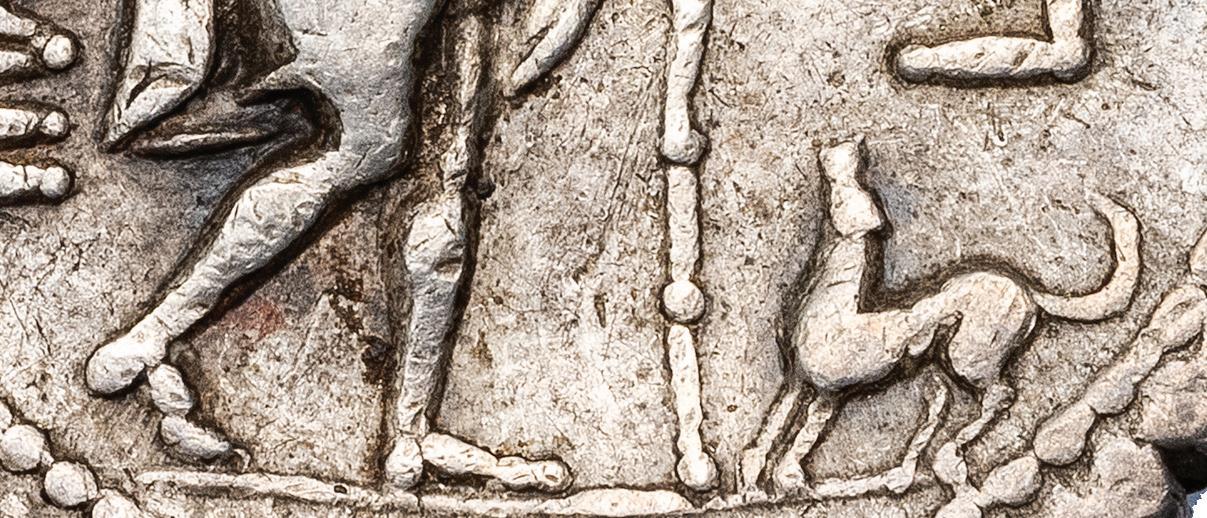
53 (18825). ROMAN REPUBLIC. C. MAMLIUS LIMETANUS, 82 BC.
Silver serrate denarius, 3.81 g, 20 mm. Issue of Rome.

Obv. Draped bust of Mercury right, wearing petasus and holding caduceus. Rev. C MAMIL LIMETAN, Ulysses (Odysseus) greeting his dog Argos who looks up and wags his tail in recognition.
Crawford 362/1; Sydenham 741.
Ex Southern Collector; ex Berlin Surgeon, Hirsch 279, lot 2121, “acquired before 1895.” VF.
The reverse type recounts the episode in Homer’s Odyssey 17.290 ff, when a disguised Odysseus, home after the Trojan War, is recognized by his faithful dog Argos:
“[290] Thus they spoke to one another. And a hound that lay there raised his head and pricked up his ears, Argos, the hound of Odysseus, of the steadfast heart…yet even now, when he marked Odysseus standing near, he wagged his tail and dropped both his ears, but nearer to his master he had no longer strength to move. Then Odysseus looked aside and wiped away a tear… [324] So saying, (Odysseus) entered the stately house … But as for Argos, the fate of black death seized him straightway when he had seen Odysseus in the twentieth year...” (Odyssey 17.290 ff in the A.T. Murray translation).
34
54 (18831). ROMAN IMPERATORIAL. M. JUNIUS BRUTUS, d. 42 BC. Silver denarius, 4.00 g, 20 mm. Issue of Rome, struck by Brutus while he served as moneyer, 54 BC. Obv. LIBERTAS, head of Libertas right. Rev. BRVTVS, procession of L. Junius Brutus, consul of 509 BC, and lictors. Crawford 433/1; Sydenham 906.
Ex Southern Collector; ex Berlin Surgeon, Hirsch 279, lot 2108, “acquired before 1895.” VF.
Although this coin was struck years before M. Junius Brutus made the fateful decision to become one of the liberators of Rome by striking down Julius Caesar in 44 BC, it is somewhat uncanny how the types advertise the motive behind one of the most famous murders in ancient history. However, when Brutus chose the types for his denarii, he was actually trying to connect himself to the greatness of his famous ancestor rather than plotting the future. Both obverse and reverse types refer to L. Junius Brutus, who was responsible for expelling L. Tarquinius Superbus, the last Etruscan king of Rome from the city and inaugurating a new era of liberty for the Romans. This new freedom from the haughtiness of kings is illustrated by the personification of Libertas on the obverse. Following the overthrow of the Etruscan kingship in 509 BC, L. Junius Brutus established a new republican form of government in which supreme authority was granted to two annually elected officials called consuls, of which Brutus was one. He is shown on the reverse of this coin in procession flanked by lictors carrying the fasces (bundles of rods and axes symbolic of the consuls’ power of corporal and capital punishment) emblematic of the consular office.
55 (18836). ROMAN IMPERATORIAL. JULIUS CAESAR, d. 44 BC.
Silver denarius, 3.60 g, 18 mm. Lifetime issue of C. Cossutius Maridianus minted in Rome, February-March 44 BC. Obv. CAESAR PARENS PATRIAE, veiled head of Julius Caesar right, apex behind, lituus in front. Rev. C COSSVTIVS MARIDIANVS, legend shown in a cross-shaped design, A - A - A - FF between the arms of the cross. Crawford 480/19; Sydenham 1069.
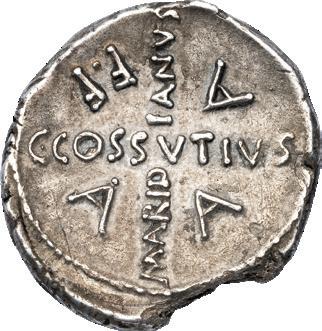

Ex Southern Collector, ex Hirsch 279, lot 2215 = Gorny & Mosch Giessener Münzhandlung 73, 10/11/1995, lot 297. NGC graded CHOICE VF, Strike 5/5, Surface 2/5, “edge flaw” noted (actually an ancient imperfection from the production of the planchet on which the coin was struck).
The obverse of this coin features an expressive portrait of Caesar after his assumption of the Roman dictatorship and in the days leading up to his assassination on the Ides of March, 44 BC. Interestingly, the type emphasizes his religious and moral authority rather than his political authority as dictator - a propaganda ploy that would later be used to full effect by his heir, Augustus. Here Caesar is named “Parent of his Country,” a title that was given to him by the Senate in thanks for his ending of the Civil War, while the veil, apex and lituus refer to his status as both an augur and as one of the members of the pontifical college. The strictly epigraphic reverse provides the full name of the moneyer in the form of a cross and gives the official abbreviation of his office as one of the “[tresviri monetales] a[re] a[rgento] a[uro] f[lando] f[eriundo]” (“ three men for casting and striking bronze, silver and gold”).




35 KINGS, TYRANTS AND LIBERATORS
56 (18820). ROMAN EMPIRE. AUGUSTUS, 27 BC-14 AD. Silver denarius, 3.81 g, 19 mm. Issue of a Spanish mint, perhaps Colonia Patricia, ca. 19 BC. Obv. CAESAR, bare head of Augustus left, within dotted circle. Rev. OB CIVIS SERVATOS, within oak wreath (corona civica). RIC I rev 77b.
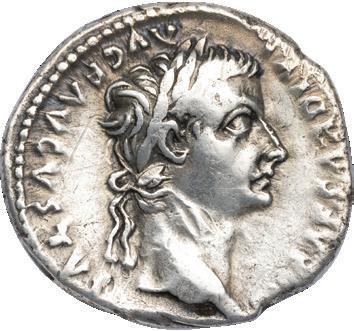
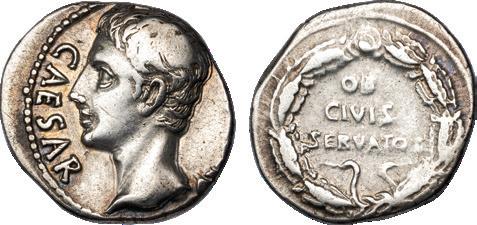
Ex Southern Collector; ex Hirsch 279, lot 2253, “acquired 1980, Beckenbauer, Munich.” VF, areas of flat strike, extremely rare variety with head facing left.
The reverse type, an oak crown called the corona civica, was an honor bestowed upon Augustus by the Senate “for saving citizens” (ob civis servatos). Originally the corona civica was a military decoration given to a soldier who saved a colleague’s life in war, but here the Senate symbolically awarded it to Augustus for protecting the lives of Roman citizens by bringing the Civil War to an end. The type became a staple of Roman imperial iconography and was used in art and coinage throughout the Julio-Claudian dynasty and beyond - see for instance cat. nos. 65 and 69.



THE BERLIN SURGEON’S TRIBUTE PENNY
57 (18829). ROMAN EMPIRE. TIBERIUS, AD 14-37. Silver denarius, 3.60 g, 18 mm. Issue of Lugdunum (Lyon). Obv. TI CAESAR DIVI AVG F AVGVSTVS, laureate head of Tiberius right. Rev. PONTIF MAXIM, female figure (Livia as Pax), seated right on throne with decorated legs, holding scepter and olive branch. RIC I rev 30.

Ex Southern Collector; ex Berlin Surgeon, Hirsch 279, lot 2276, “acquired before 1895.” VF, scratches in field.
This is an example of the famous coin commonly regarded as the “tribute penny” mentioned in the Bible - see cat. no. 67 for a detailed historical note documenting this coin type.
58 (18823). ROMAN EMPIRE. PROVINCIAL ISSUE OF BLAUNDOS, PHRYGIA UNDER NERO, AD 54-68. Bronze AE20, 5.21 g, 20 mm. Obv. ΝΕΡΩΝ ΚΑΙΣΑΡ, youthful head of Nero right. Rev. ΤΙ ΚΛΑΥ



ΒΛΑΥΝΔΕΩΝ, Apollo standing right with lyre and plectrum.
RPC 3059.
Ex Southern Collector; ex Berlin Surgeon, Hirsch 279, lot 2276, “acquired before 1895.” Good VF, a scarce provincial emission with a remarkable portrait of Nero as a boy.
36
ΚΑΛΛΙΓΕΝΗΣ
59 (18834). ROMAN EMPIRE. NERVA, AD 96-98. Silver denarius, 3.19 g, 18 mm. Issue of Rome.
Obv. IMP NERVA CAES AVG P M TR P COS III P P, laureate bust of Nerva right. Rev. CONCORDIA EXERCITVVM, clasped hands, military standard above prow in the background. RIC II 15.



Ex Southern Collector; ex Berlin Surgeon, Hirsch 279, lot 2388, “acquired before 1895,” with partial ink-written ticket. Good VF, marks and slight porosity.
60 (18828). ROMAN EMPIRE. TRAJAN, AD 98-117. Silver denarius, 2.92 g, 19 mm. Issue of Rome, ca. AD 112-114.

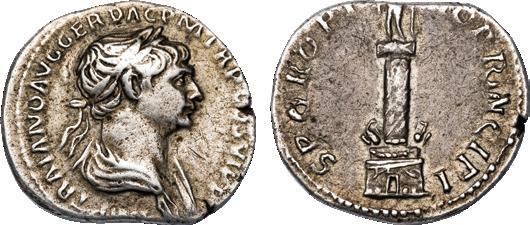
Obv. IMP TRAIANO AVG GER DAC P M TR P COS VI P P, draped and laureate bust of Trajan right. Rev. S P Q R OPTIMO PRINCIP[I], Trajan’s column with the emperor’s statue on top. RIC II 292.
Ex Southern Collector; ex Berlin Surgeon, Hirsch 279, lot 2400, “acquired before 1895,” with partial ink-written ticket. Good VF, minor circulation marks.
This denarius depicts one of Rome’s most famous architectural monuments, the great column erected in Trajan’s Forum that stands in Rome to this day. Along the column is a continuous helical relief with images recording the Roman campaigns against the Dacians, detailed representations of the people, landscape, military activities, and battles that form our best extant record of these events.


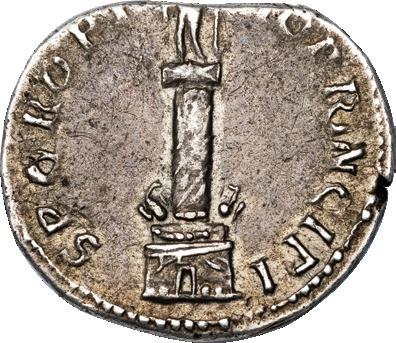
37
cat. no. 59 cat. no. 60
61 (18830). ROMAN EMPIRE. MARCUS AURELIUS, AD 161-180.
Silver denarius, 3.15 g, 18 mm. Issue struck while serving as Caesar, AD 140-144.
Obv. (AV)RELIVS CAESAR AVG PII F COS, youthful head right. Rev. PIETAS AVG, sacrificial utensils. RIC III 424a (Antoninus Pius).



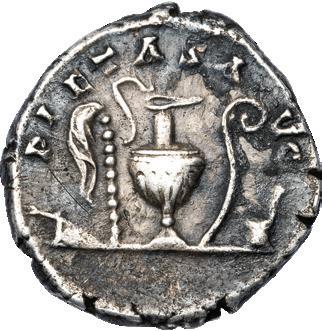


Ex Southern Collector; ex Berlin Surgeon, Hirsch 279, lot 2475, “acquired before 1895,” with partial ink-written ticket. VF, traces of black encrustation.
62 (18833). ROMAN EMPIRE. MARCUS AURELIUS, AD 161-180.
Silver denarius, 3.28 g, 18 mm.
Obv. M ANTONINVS AVG TR P XXIII, Laureated head of Marcus right. Rev. FELICITAS AVG COS III, Felicitas standing left. RIC III 203.
Ex Southern Collector; ex Berlin Surgeon, Hirsch 279, lot 2474, “acquired before 1895.” XF.
63 (18835). ROMAN EMPIRE. FAUSTINA THE YOUNGER, WIFE OF MARCUS AURELIUS (died 175 AD).
Silver denarius, 3.31 g, 17 mm.



Obv. FAVSTINA AVGVSTA, draped bust of Faustina right. Rev. FECUNDITAS, Fecunditas standing left, holding two children in her arms while two others stand on either side. RIC II 676.
Ex Southern Collector; ex Berlin Surgeon, Hirsch 279, lot 2487, “acquired before 1895.” VF, dark toning.
38
RARE AUREUS SHOWING A BARBARIAN OFFERING HIS SON TO AUGUSTUS FROM MARIO RATTO’S 1949 FPL
64 (18837). ROMAN EMPIRE. AUGUSTUS, 27 BC-AD 14. Gold aureus, 7.81 g, 19 mm. Issue of Lugdunum (Lyon), 8 BC.

Obv. AVGVSTVS DIVI F, laureate head of Augustus right. Rev. IMP XIIII, German or Gaul standing right, handing his son to Augustus seated on curule chair placed on platform.

RIC I 200; Calicó 235; Biaggi 123.


Ex Southern Collector; ex CNG Triton XX, 1/10/2017, lot 631 = ex Mario Ratto FPL III (Milan, 1949), 15.
NGC graded CHOICE VF, Strike 4/5, Surface 3/5.
A rare and seldom-encountered type, this coin celebrates the victories of Tiberius in Germany, consolidating the inroads made by Drusus. The imagery focuses on a “barbarian,” likely a German, dressed in a long cloak, presenting his infant to Augustus to be brought up at the Roman court, in what was likely a guarantee of loyalty to Rome. A very similar depiction of this scene appears on one of the famous Boscoreale silver cups, where a pair of Germans kneel in front of a similarly seated emperor, bringing their sons forward.




39
BOSCOREALE CUP
65 (18821). ROMAN EMPIRE. AUGUSTUS, 27 BC-14 AD.
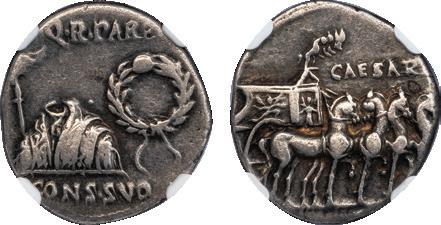
Silver denarius, 3.62 g, 18 mm. Issue of a Spanish mint, perhaps Colonia Caesaraugusta, ca. 19-18 BC. Obv. Head of Augustus right, wearing oak wreath (corona civica). Rev. CAESAR AVGVSTVS, two laurel trees flanking shield inscribed CL V; S-P/Q-R around.
RIC I rev 36a (rarity R3).
Ex Southern Collector; ex CNG Triton XII, 1/6/2009, lot 535 = William C. Boyd Collection, Baldwin’s 42, 9/26/2005, lot 188, together with Boyd’s original ticket indicating purchase from Seltman in 1898. Presumably this refers to the E.J. Seltman Collection sold by Leo Hamburger on 6/13/1892, and although this denarius is not among the coins offered in that catalogue it may have been sold by private treaty.
NGC graded CHOICE XF, Strike 4/4, Surface 4/4, with superb golden iridescent highlights throughout.
An important coin for Augustan propaganda, this issue depicts the great honors bestowed on Octavian by the Senate in 27 BC, when he assumed the new name of Augustus. The corona civica was an oak wreath traditionally awarded to a soldier for saving the life of a Roman citizen. It was granted to Augustus symbolically for saving the lives of all Roman citizens by ending the bloody cycle of civil wars of the late Republic. The laurel trees represent those that were planted to flank the door of Augustus’ house in honor of his victories and in recognition of his association with Apollo. The inscribed shield is the clipeus virtutis, which was awarded to Augustus in honor of his courage, clemency, justice, and piety. It was prominently displayed in the Curia Julia whenever the Senate met.
AUGUSTAN DENARIUS FROM THE ARCHER HUNTINGTON COLLECTION ONCE ON EXHIBIT AT THE AMERICAN NUMISMATIC SOCIETY IN NEW YORK
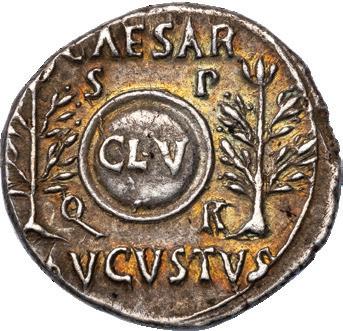

66 (17884). ROMAN EMPIRE. AUGUSTUS, 27 BC-14 AD.

Silver denarius, 3.73 g, 17 mm. Issue of a Spanish mint, perhaps Colonia Caesaraugusta, ca. 18 BC. Obv. [S P] Q R PARE[NT] - CONS SVO, aquila, toga picta over tunica palmata, and wreath. Rev. CAESARI AVGVSTO, slow quadriga right, figures of Victories on its side and finial with galloping horses on top.
RIC I rev 99.
Ex Archer M. Huntington Collection, ANS 1001.1.22826; ex CNG 118, 9/13/2021, lot 965 = CNG Electronic Auction 397, 5/17/2017, lot 460.
NGC graded CHOICE VF, Strike 4/5, Surface 3/5, with a very old and prestigious pedigree.
The typology of this denarius marks an important turning point in Roman custom. Previously all victorious Roman commanders could potentially be awarded a triumph, but under Augustus triumphs became the sole prerogative of the emperor. As indicated by the coin legend, the aquila, toga picta and tunica palmata, wreath and triumphal chariot depicted are given by the “Senate and People of Rome to its protective parent [i.e., Augustus].” This was not a single triumphal award, but for all time. The Fasti Triumphales, which documented all Roman commanders awarded triumphs, ceased recording the year before this coin was struck.

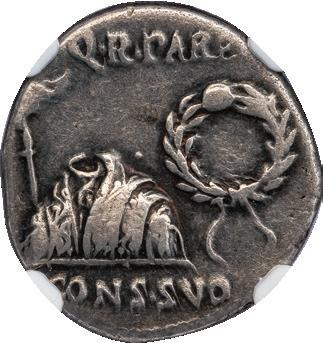
40
Golden toned augustan denarius likely from the e.j. seltman collection 1898
A SPECTACULAR MULTICOLORED SPECIMEN OF THE “TRIBUTE PENNY” MENTIONED IN THE BIBLE
67 (18838). ROMAN EMPIRE. TIBERIUS, AD 14-37. Silver denarius, 3.70 g, 18 mm. Issue of Lugdunum (Lyon). Obv. TI CAESAR DIVI AVG F AVGVSTVS, laureate head of Tiberius right. Rev. PONTIF MAXIM, female figure (Livia as Pax), seated right on throne with decorated legs, holding scepter and olive branch. RIC I rev 30.
Ex Southern Collector; ex Vilmar Numismatics 2013, privately purchased from Jonathan Kern; ex Prof. Luigi de Nicola, Rome, ca. 1950s-1960s, with his custome-printed brown envelope and small circular orange tag. NGC encapsulated with a grade of AU STAR, Strike 5/5, Surface 5/5, a truly amazing coin with stunning multicolored iridescence throughout and an amazingly expressive portrait of Tiberius. Luigi de Nicola was an Italian dealer active in the 1950s-1960s in Rome. A pair of coins presently in the collection of the University of Birmingham, were from the collection of Geoffrey Colton Haines who acquired them from de Nicola in 1959, when he resided at Via del Babuino, 65, the same address noted on his custom-printed envelope.
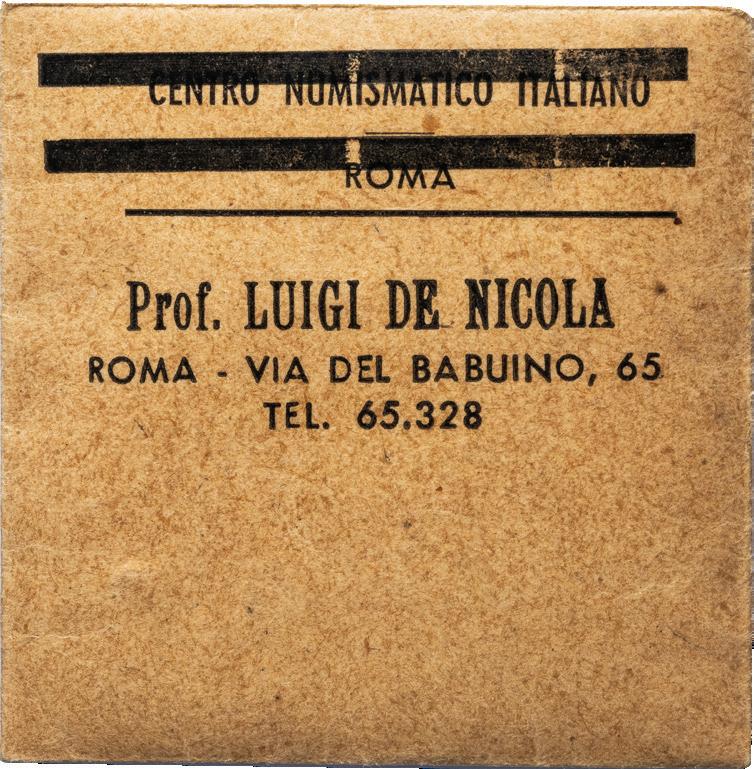
This denarius of Tiberius is spectacular not only thanks to its strongly struck obverse and reverse, but also due to it striking iridescent toning. The coin is arguably one of the most famous types in the denarius coinage of the early Julio-Claudian emperors. It is widely believed that a specimen from this denarius series of Tiberius was the very coin handed to Jesus when he was questioned by the Pharisees and Herodians about the legitimacy of paying taxes to Rome. Although their intention was to get him to speak against the Romans and thereby obtain an excuse for his arrest, Matthew 22:19-21 reports that Christ responded to his questioners by saying, “‘Show Me the coin used for the poll-tax.’ And they brought Him a denarius. And He said to them, ‘Whose likeness and inscription is this?’ They said to Him, ‘Caesar’s.’ Then He said to them, ‘Then render to Caesar the things that are Caesar’s; and to God the things that are God’s.’ And hearing this, they were amazed, and leaving Him, they went away.”

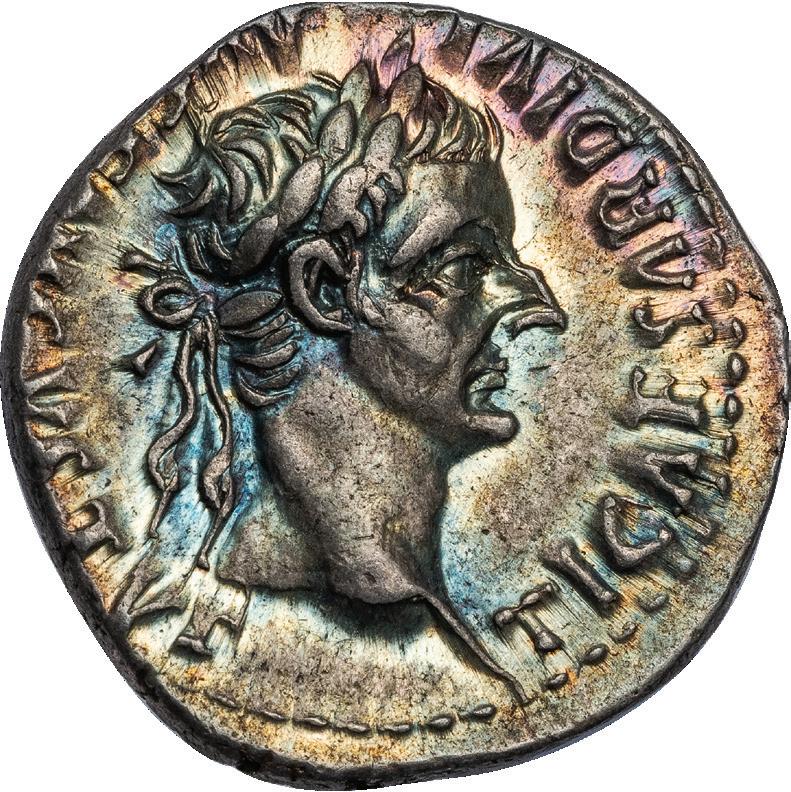
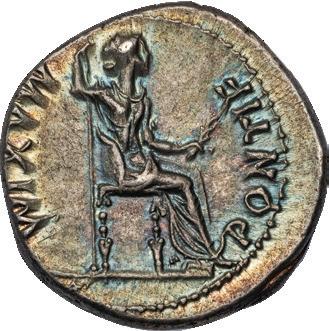


The Tiberius denarius type is frequently described by numismatists as the “Tribute Penny” type because in the influential King James Version of the story in Matthew (paralleled also in Mark 12:13-17 and Luke 20:20-26) the Greek word denarion (= Latin denarius) is rendered as “penny” in English. This translation was designed to make the ancient denarius comprehensible to English people of the seventeenth century. It was not entirely inappropriate considering that the early modern English penny evolved from the medieval denier, which had in turn developed from the Roman denarius.

41
68 (18465). ROMAN EMPIRE. GAIUS (CALIGULA), AD 37-41.
Silver denarius, 3.79 g, 19 mm. Issue of Lugdunum (Lyon), AD 37. Obv. [C CAESAR] AVG GERM P M TR POT, laureate head of Caligula right. Rev. AGRIPPINA M[AT C CAES AV]G GERM, draped bust of Agrippina the Elder right.
RIC I rev, 8.
NGC graded CHOICE XF, Strike 3/5, Surface 4/5, old cabinet patina with orange iridescent highlights throughout.
As a child, the future emperor Gaius gained the nickname Caligula (“Little Boots”) from soldiers campaigning in Gaul with his beloved father, Germanicus in AD 14-16. Unfortunately, in AD 19, Germanicus suddenly fell ill and died, after which, Agrippina Senior (“the Elder”), pressed for Tiberius to recognize her elder sons, Nero and Drusus, as heirs. This brought her into frequent conflict with Sejanus, the praetorian prefect, who had his own plans to insert himself into the imperial succession. At last, unwilling or unable to settle the struggle between Agrippina and Sejanus, Tiberius decided to withdraw from Rome and live on the island of Capri in AD 26. In his absence, Sejanus engineered the arrest and exile of Agrippina and Nero on treason charges in AD 29. Drusus was imprisoned in AD 30. All three died in their confinement in AD 33. This left Gaius, who had accompanied Tiberius to Capri, as the only living son of Germanicus’ house. Thanks to his friendly relationship with the ailing emperor, Gaius managed to have himself named as heir of Tiberius in AD 35. When Tiberius died two years later, perhaps with Gaius’ assistance, Gaius became the third emperor of the JulioClaudian dynasty.
This beautiful denarius was struck in the year of Gaius’ accession and features magnificent portraits of both the new emperor and his mother. These types served to advertise the promise of the young emperor after the unpleasant reign of the elderly Tiberius. The titulature presents Gaius as both heir of Augustus and a son of Germanicus, alluding to his much-loved male forebears, while the reverse type illustrates his filial piety towards his mother. This was also expressed by his visit to the island of Pontia to reclaim the ashes of Agrippina and return them to Rome. In short, this denarius represents Gaius’ strong desire to be viewed as a good ruler opposed to the mismanagement and political terror that had taken place under Tiberius. Alas, soon after this promising start, in AD 40, Gaius began a nightmarish descent into madness that, according to Suetonius, included belief in his own divinity, declaring war on Poseidon and ordering his soldiers to attack the sea, and even appointing his horse a senator. His reign of depravity was brought to an end by the assassin’s dagger in AD 41 after he threatened to remove the imperial capital from Rome to Alexandria in Egypt.
69 (18562). ROMAN EMPIRE. CLAUDIUS, AD 41-54.


Silver denarius, 3.79 g, 18 mm. Issue of Rome, AD 41-2. Obv. [TI ]CLAVD CAESAR AVG GERM P M TR [P], laureate head of Claudius right. Rev. EX S C / OB CIVES / SERVATOS, within oak wreath (corona civica).
RIC I rev 16 (rarity R2).
NGC graded XF, Strike 4/5, Surface 3/5, with pleasing icy blue iridescent highlights.
The corona civica type makes direct reference to the same theme on Augustus’ coinage (see cat. no. 56); here Claudius is being hailed as the savior of Rome’s people from internal conflict following the assassination of Caligula.


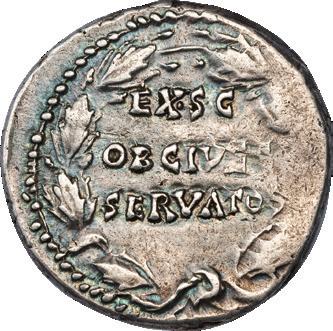

42
A SUPERB AS OF CLAUDIUS FROM THE VAUTIER AND COLLIGNON COLLECTIONS SOLD IN 1922
70 (18822). ROMAN EMPIRE. CLAUDIUS, AD 41-54. Bronze as, 10.88 g, 28 mm. Issue of Rome, AD 42-43.


Obv. TI CLAVDIVS CAESAR AVG P M TR P IMP P P, bare head left. Rev. CONSTANTIAE AVGVSTI, Constantia standing left, wearing helmet and paludamentum, raising hand and holding spear. RIC I rev 111.

Ex Southern Collector; ex Leo Benz Collection, Lanz 94, 11/22/1999, lot 215 = Lanz 26, 12/5/1983, lot 465 = ex Paul Vautier and Prof. Maxime Collignon Collections, Naville, Ars Classica II, 6/12/1922, lot 278.
Good XF, with an exceptional portrait of Claudius and a pleasing glossy black patina, described in Naville’s catalogue as being “de toute beauté.”
In the preface to the 1922 catalogue focused entirely on Roman coins coming from the Vautier and Collignon collections, the editors praised the taste of the two collectors as follows: “These two collections fit together exceptionally well as they were composed following similar principles. In studying Roman coins, Mr. Vautier and Mr. Collignon made it their goal to bring together specimens in perfect condition and of the best style. Mr. Vautier, son and brother to painters of great renown, certainly had exceptional taste. As regards to the collection assembled by Maxime Collignon, his famous works on Greek art, in particularly sculpture, have assured a place for him among the great connoisseurs of ancient art...”




43
NERO’S PORT OF OSTIA SESTERTIUS FROM THE SIGMUND KRAUSZ COLLECTION SOLD BY ADOLPH CAHN IN 1925
71 (18674). ROMAN EMPIRE. NERO, AD 54-68.

Brass sestertius, 29.27 g, 35 mm. Issue of Rome, ca. AD 64.
Obv. NERO CLAVD CAESAR AVG GERM TR P IMP P P, laureate head of Nero, wearing aegis, right. Rev. AVG[VSTI], Portus Augusti: seven ships within the harbor; pharos or basis surmounted by a statue of Neptune at top; reclining figure of water god (probably Portus), holding a rudder and dolphin, at bottom; crescent-shaped pier with portico, terminating with figure sacrificing at altar in front of building, to left; crescent-shaped row of breakwaters, terminating with a figure seated on rock, to right; POR OST flanked by S-C in exergue.
RIC I rev, 180 (rarity given as R2); WCN 97; BMCRE 134; BN 290.
Ex Jesus Vico, 162, 7/12/2022, lot 130 = Gorny & Mosch Giessener Münzhandlung 50, 9/24/1990, lot 540 = V. J. E. Ryan Collection, Glendining, 4/2/1952, lot 2286 = Sigmund Krausz Collection (Chicago), Adolph Cahn 54, 9/9/1925, lot 119a.
NGC graded XF, Strike 5/5, Surface 2/5, FINE STYLE, “smoothing,” a nicely struck and well-preserved specimen depicting one of the most memorable architectural types on Roman coinage. RIC 180 is the rarest of six different varieties as noted in RIC, with a rating of R2. The first recorded owner of this coin was Sigmund Krausz, a well-known documentary photographer of American life and customs and a charter member of the Chicago Coin Club.
Ostia had served as the harbor city of Rome at the mouth of the Tiber since the seventh century BC. It operated as a Roman naval base during the First Punic War (264-241 BC) and in the second century BC became critical for the import of grain for the expanding population of Rome. Unfortunately, because the natural harbor of Ostia was located on the mouth of the Tiber River, it was exposed to the southwest wind and was often subject to severe storms that caused flooding up the river in Rome itself. In order to solve these problems, in AD 46, Claudius began construction of a new artificial harbor further to the north of Ostia but connected to the Tiber through a channel. This was known as Portus Augusti (“the Port of Augustus”). The new harbor was octagonal in shape and enclosed an area of about 617 acres (250 hectares) with piers, breakwaters and harbor buildings. To guide ships safely to the entrance of the new facility, a pharos (lighthouse) was erected on an artificial island created by sinking a massive ship that had been constructed to transport an obelisk from Egypt to Rome in the reign of Caligula.
The present sestertius was struck under Nero, the adopted son and successor of Claudius, possibly to celebrate the completion of the Portus Augusti, although the port was already operational under Claudius. It features one of the most famous and desirable architectural coin types in the entire Roman Imperial coin series. In tremendous detail, the reverse represents the entirety of the Portus Augusti, including the pharos and the ships anchored within. As such, it provides priceless information on the appearance of the port in its heyday and conveys to the modern collector some impression of what it must have been like to walk on the piers and conduct business at the port of Rome.
The reclining water god at the bottom of the port scene is frequently described as the personification of the Tiber River or as Neptune or Oceanus. However, comparison with provincial coins of Pompeiopolis featuring the personification of that city’s harbor has led to the suggestion that the deity on Nero’s sestertii is the personification of Portus itself. Likewise, the statue that surmounts the pharos has been variously identified as an image of Neptune or of Nero, who had quite a reputation for megalomania. It has been argued recently that the statue on the coin is that of Neptune based on an Ostian mosaic which clearly shows a statue of this god standing in front of the lighthouse on its artificial island. There is no ancient descriptive evidence for a statue on top of the lighthouse of the Portus Augusti.
Alas, while the construction of the Portus Augusti was a great achievement of engineering and architecture, it ultimately failed in its goal to prevent flooding and to protect grain shipping. Already in AD 62, a few years before Nero celebrated the completion of the port with this sestertius issue, a severe storm caused 200 ships to sink inside the protected harbor. This continuing problem ultimately caused Trajan to construct a new artificial harbor, the Portus Traiani Felicis, further inland in AD 100-112.
44






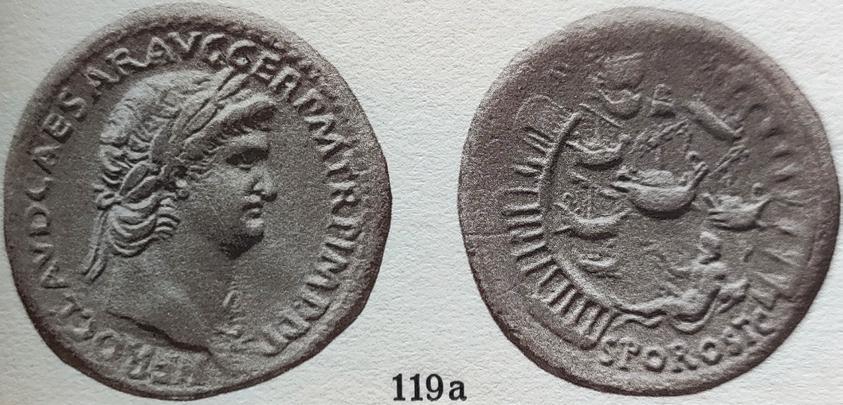
45
72 (18619). ROMAN EMPIRE. VESPASIAN, AD 69-79. Silver denarius, 3.55 g, 18 mm. Issue of Ephesus, AD 71.

Obv. IMP CAESAR VESPAS AVG COS III TR P P P, laureate head of Vespasian right. Rev. CONCORDIA AVG, Ceres seated left on throne, holding grain ears and poppy in right hand, cornucopia in left; EPHE (ligate) in exergue. RIC II.1 rev, 1428; BMCRE 453; BN 343; RPC I, 830. Ex Numismatik Lanz 109, 5/27/2002, lot 344.


NGC graded MINT STATE, Strike 4/5, Surface 4/5, FINE STYLE, an exquisite example struck on a nicely-toned planchet, with golden hues highlighting the coin’s devices.
73 (18467). ROMAN EMPIRE. SEPTIMIUS SEVERUS, AD 193-211. Gold aureus, 7.21 g, 20 mm. Issue of Rome, AD 203-210.
Obv. SEVERVS PIVS AVG, laureate head of Septimius Severus right. Rev. VICTORIA PARTHICA MAXIMA, Victory, in flowing robes, advancing left, holding wreath and palm branch.
RIC IV, 297; Calicó, 2567 (same dies); Biaggi 1113 (same dies).
NGC graded AU, Strike 5/5, Surface 5/5, a lustrous specimen, awarded by NGC its coveted top ratings for strike and surface.
Although this attractive aureus lacks the imperial titulature that would allow for a precise dating, the reverse type and legend referring to “the greatest Parthian victory” links it to celebrations related to Severus’ successful campaigns against the Parthian empire (AD 197200) and to his sack of the Parthian capital at Ctesiphon in AD 198. For this signal victory, the emperor accepted the honorific title of Parthicus Maximus. Gold coins like the present piece were distributed to the soldiers as donatives, both to reward them for their service in the Parthian campaigns and as a means of ensuring their future loyalty. Indeed, on his deathbed, Severus is famously said to have advised his discordant sons to “Be harmonious, enrich the soldiers, and scorn all others” (Dio 76.15.2-3). This coin may have been distributed for the enrichment of the soldiers as part of the celebrations of Severus’ decennalia (ten-year anniversary) that began in AD 202, but continued through 204, with the erection of the Arch of Septimius Severus in Rome, a monument which chronicled his Parthian victories and triumph, and the celebration of the ludi saeculares
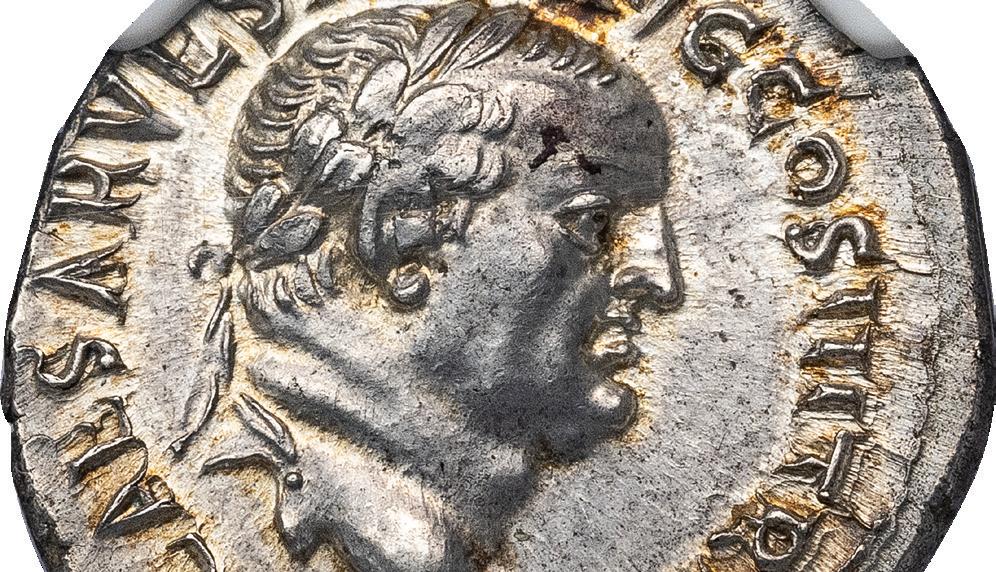
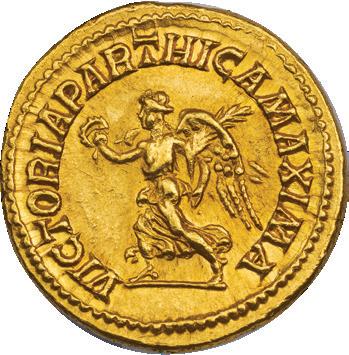



46
cat. no. 73
cat. no. 72
HERACLES FIGHTING THE HYDRA ON A MEDALLION OF HERACLEA IN BITHYNIA

74 (18844). ROMAN EMPIRE. PROVINCIAL ISSUE OF HERACLEA, BITHYNIA, UNDER GORDIAN III, AD 238-244. Bronze medallion, 17.03 g, 37 mm. Obv. Μ ΑΝΤ ΓΟΡΔΙΑΝΟC ΑYΓ, laurate, draped and cuirassed bust of Gordian right. Rev. ΗΡΑΚΛΕΩΤΑΝ ΜΑΤΡΟC


ΠΟΛΙΩΝ, Heracles standing left, holding club overhead, preparing to strike the Lernean hydra wrapped around his foot; bow and quiver in right field.
RPC VII.2 2086 (with 7 specimens cited on RPC Online, this coin being no. 7); Waddington, Recueil Général, 217 (same reverse die); Voegtli, Bilder der Heldenepen in der kaiserzeitlichen griechischen Munzprägung, Type 2j. Ex Southern Collector, ex CNG Esale 460, 1/29/2020, lot 403; ex Roma Numismatics Electronic Auction 53, 2/7/2019, lot 602. NGC graded CHOICE VF STAR, Strike 5/5, Surface 4/5, “edge pinch.”
This is a marvelous depiction of Heracles’ Second Labor in which he destroys the Lernean Hydra. Among the herro’s most famous feats, the scene is depicted often in ancient art, from Greek vases to Roman stone sarcophagi. On the coin Heracles is shown engaging the monster with his club, grabbing one of its many heads. In right field are the hero’s other attributes, his bow and arrows, here making a reference to the outcome of the battle. After killing the hydra and burying its one “immortal” head, Heracles used the creatures’ deadly blood as poison for his arrows. The arrows so poisoned were later used to kill both the Stymphalian Birds during his Sixth Labor and the monstrous giant Geryon during his Tenth Labor. Unfortunately, the blood of the Hydra would ultimately be the undoing of Heracles. One of the poisoned arrows was used to slay the wily centaur Nessus, but before he died, he convinced the hero’s wife Deianeira to dip her husband’s tunic into his now-tainted blood, promising that it would guarantee the future faithfulness of Heracles. When Heracles put on the poisoned tunic, it killed his mortal nature and allowed him to ascend to Olympus as a new god.
47
ΑΠΟΙΚΩΝ
HERACLES AND THE CERYNEIAN HIND ON A MEDALLION OF ANCHIALUS


75 (18839). ROMAN EMPIRE. PROVINCIAL ISSUE OF ANCHIALUS, PHRYGIA, UNDER GORDIAN III, AD 238-244. Bronze medallion, 35.55 g, 37 mm. Obv. Laureate, draped, and cuirassed bust left, holding spear and shield decorated with eagle. Rev. Heracles and the Ceryneian HindHeracles standing left, grasping the antlers of the Ceryneian Hind with both hands and leaning on the animal’s back with his right knee. RPC VII.2 1100 (with 10 specimens listed on RPC Online, this coin being no. 6); Yanislav Tachev, The Coinage of Аnchialos (Sofia, 2018), p. 626, pl. 128, no. 14 (this coin illustrated); AMNG II 622; Varbanov 639; Voegtli, Bilder der Heldenepen in der kaiserzeitlichen griechischen Munzprägung, Type 3j.
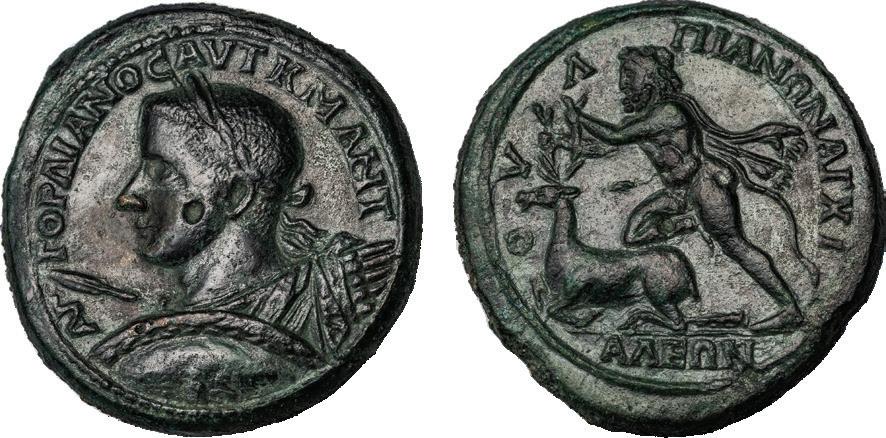
Ex Southern Collector; ex Benito Collection, CNG 114, 5/13/2020, lot 502 = Gemini III, 1/9/2007, lot 433. Near EF, dark olive-green patina under lacquering, with some repatination, smoothing and minor tooling; a rare type, one of only 10 specimens cited by RPC (ineligible for encapsulation).
The Third Labor imposed on Heracles by King Eurystheus of Tiryns was the capture of the Ceryneian Hind - a golden-horned and firebreathing deer the size of a bull that roamed along the banks of the River Cerynites in Achaea. This was a tricky labor for Heracles because he could not simply kill the animal, which was sacred to Artemis, but had to bring it back alive. After hunting the Ceryneian Hind for a year, Heracles finally captured it, either by throwing a net over it while the animal slept (Diod. 4.13) or by wounding it with an arrow as it crossed the River Ladon (Apollodorus 2.5.3-4). This coin of Anchialus seems to preserve an alternate version of the labor that is not mentioned by the ancient literary sources. Here Heracles grasps the hind by the antlers and forces it into submission with his knee placed firmly on the animal’s back. His need to bring it in alive is underlined by the placement of his club on the ground.
48
76 (18468). ROMAN EMPIRE. ROMAN EMPIRE. CONSTANTIUS I, AD 305-306. Gold aureus, 5.36 g, 20 mm. Issue of Cyzicus, struck while serving as Caesar, AD 294. Obv. CONSTAN-TIVS NOB C, laureate head of Constantius I right. Rev. FIDES M-I-LITVM, Fides standing facing, looking right, holding military standards. RIC VI, 1; Depeyrot, 15/1.
NGC graded CHOICE AU STAR, Strike 5/5, Surface 4/5, a superb specimen, perfectly centered and with a gem-like quality, struck for Constantius I, father of Constantine the Great.
A UNIQUE AND SEEMINGLY UNPUBLISHED GOLD ISSUE STRUCK BY LICINIUS AT THESSALONICA



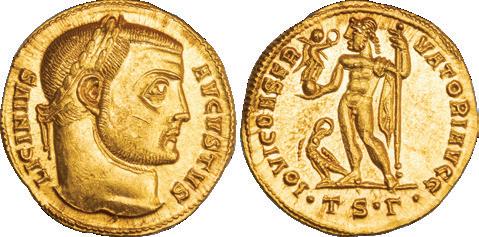


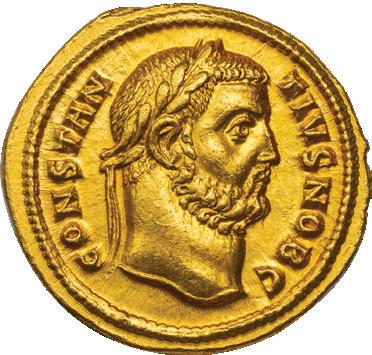

77 (13458). ROMAN EMPIRE. LICINIUS I, AD 308-324. Gold aureus, 5.02 g, 20 mm. Issue of Thessalonica, ca. AD 313-316. Obv. LICINIVS AVGVSTVS, laureate head right. Rev. IOVI CONSER-VATORI AVGG, Jupiter standing left, holding Victory on globe, eagle with wreath at his feet, •TS•Γ• in exergue. RIC unlisted, but cf. RIC VI, 44a for obverse type and RIC VII, 2 for reverse type; Calicó -, cf. 5121 (Jupiter with thunderbolt, different renderings of mint markings and controls).
Ex Roma XXIII, 3/24/2022, 1077 = Vilmar Numismatics, Fixed Price List I, lot 126 = Künker 304, 3/19/2018, lot 1362 = Gorny & Mosch Giessener Münzhandlung 79, 10/14/1996, lot 706.
NGC graded MINT STATE, Strike 5/5, Surface 3/5, possibly unique and seemingly unpublished variety of Licinius from Thessalonica.
In our previous offering of this attractive and apparently unique aureus, it was proposed that it might belong to RIC VI Group III at Thessalonica, which dates to AD 310-311, based on Diocletian’s earlier use of a similar IOVI CONSERVATORI type and mint mark arrangement (TS with officina Γ) in Group I (RIC VI, 3) and the obverse titulature, with AVGVSTVS spelled out in full, which is characteristic of Group IV (RIC VI, 44a-45). However, the known coins of Group III continue the GENIO AVGVSTI and VENERI VICTRICI types of the preceding Group II so it seems odd for an aureus invoking the protection of Jupiter for the Augusti should only appear on an issue of Licinius. Likewise, the IOVI CONSERVATORI types of Group IV regularly depict Jupiter holding a thunderbolt rather than Victory, as on the present coin. Taking all of this into consideration, it seems more likely this coin is a previously unknown aureus issue dateable to AD 313-316. The reverse type and mint mark conventions are identical to those found on folles of Licinius and Constantine I at Thessalonica in this period (RIC VII, 1-2). The use of the full AVGVSTVS titulature may indicate the continued use of an obverse die from Group IV, which would indicate production at the beginning of the AD 313-316 period.
49
cat. no. 76 cat. no. 77
78 (18845). ROMAN EMPIRE. CONSTANTIUS II, AD 337-361. Gold solidus, 4.36 g, 20 mm. Issue of Ticinum, struck while serving as Caesar, ca. AD 326. Obv. Diademed head right, with upward looking gaze. Rev. CONSTANT-IVS CAESAR, Victory, walking left, holding wreath and palm, SMT in exergue.

RIC VII 196; Jameson 372 (this coin listed and illustrated); Depeyrot 19/15.
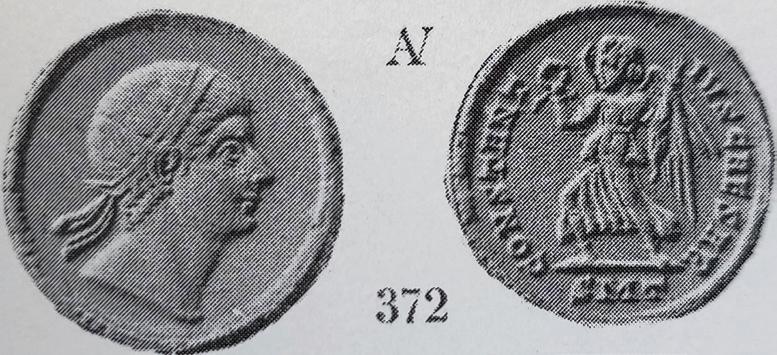
Ex Southern Collector; ex Sovereign Rarities, NYINC 2018 purchase = The New York Sale XLII, 1/9/2018, lot 468 = NAC 92, 5/24/2016, lot 2468 = Jameson Collection, 372.

NGC graded XF, Strike 5/5, Surface 3/5, a rare emission with an impeccable pedigree.
The solidus features the celebrated portrait type of the diademed and upward-gazing late Roman emperor popularized by Constantine the Great (AD 306-337). It is often interpreted as a Christianizing portrait, in which the emperor seems to be looking towards heavenly goals (or God?). However, it is rather more likely to be a portrait type intended to cast Constantius II, like his father, as a latter-day Alexander the Great destined to triumph over the Sasanian Persians. Alexander was also known for wearing a plain diadem, as represented here (in contrast to the ornate imperial diadems typical of the fourth century AD), and for his distinctive gaze.

This coin comes from the famous collection of Frèderic-Robert Jameson (1861-1942) that was formed in the late nineteenth and early twentieth century and published by the Feuardent Frères in four volumes between 1913 and 1932. After his death, the bulk of the Jameson collection was initially dispersed through the sales of Jakob Hirsch. The collection, which included over 3,000 coins, was not completely sold off until the 1980s.


50
“EYES TO GOD” OR IMPERSONATING ALEXANDER ? CONSTANTIUS II SOLIDUS EX JAMESON COLLECTION
A RARE CONTORNIATE IN THE NAME OF THE ROMAN HISTORIAN SALLUST, PUBLISHED AND ILLUSTRATED IN BOTH EDITIONS OF ALFÖLDI

79 (18843). CONTORNIATE IN THE NAME OF THE ROMAN AUTHOR SALLUST, late 4th century AD.
Bronze, 17.87 g, 36 mm.

Obv. [SALL]VSTI VS AVTOR, draped bust of Sallust right, etched solar design in right field. Rev. Sol Invictus, facing, wearing radiate crown, holding globe and saluting, riding his quadriga.



Alföldi & Alföldi, Die Kontorniat-Medaillions 107.12 (this coin listed and illustrated) = A. Alföldi, Die Kontorniaten (Budapest, 1943), pl. 47, 2 (this coin listed and illustrated).

Ex Southern Collector; ex CNG 114, 5/13/2020, lot 1027 = Phil Peck (Morris) Collection, Heritage 3071, 1/6/2019, lot 32047 = Hans M. F. Schulman, 5/3/1972, lot 880 = Thomas Ollive Mabbott Collection (Part II), H. Schulman, 10/27/1969, lot 4927 = Münzenhandlung Basel 3, 3/4/1935, lot 1070.
NGC graded CHOICE FINE, Strike 4/5, Surface 3/5, “graffito,” dark olive-green patina, with an outstanding publication history.
Gaius Sallustius Crispus, usually known simply as Sallust in English, was a Roman Republican historian and politician who lived between ca. 86 and 35 BC. He is notable as the earliest Roman historian, writing in Latin (rather than Greek) whose works still survive. The most notable of these are the Bellum Catilinae, which chronicles the failed conspiracy of L. Sergius Catilina to overthrow the Republic and establish himself as ruler in 63 BC, and the Bellum Jugurthinum, which tells the story of the war fought between the Roman Republic and Jugurtha, the king of Numidia, in 112-106 BC. Sallust was highly regarded by later Roman historians, including Tacitus, who described him as no less than a “Roman Thucydides.” His appearance on this contorniate reflects the continued appreciation of his work in late antiquity. The typology of the contorniates often looked back to cultural and political figures of the pagan Roman past as a means of resisting the increasing Christianization of Rome and its elite.
51
A SOLIDUS FROM THE BRIEF 70 DAY REIGN OF PETRONIUS MAXIMUS, EX RUSSELL BEMENT JR COLLECTION AND NFA SALE OF 1987

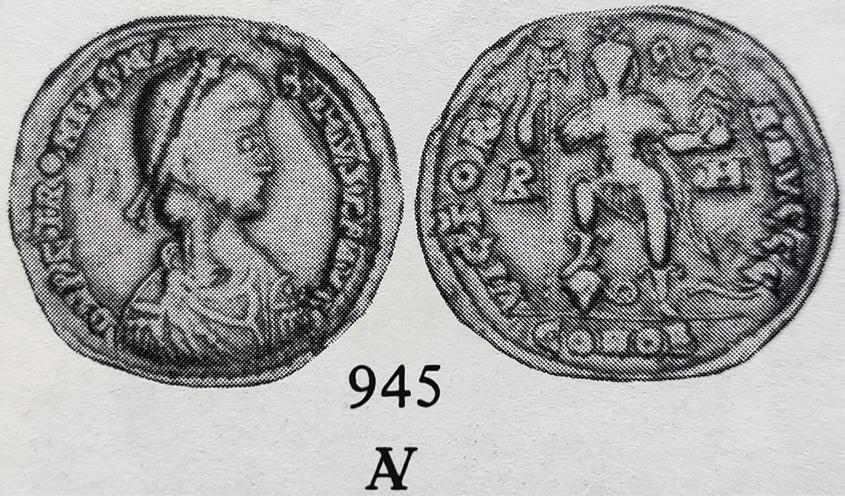



80 (18472). ROMAN EMPIRE. PETRONIUS MAXIMUS, AD 455 (March 17 - May 31).

Gold solidus, 4.25 g, 22 mm. Issue of Rome. Obv. D N PETRONIVS MA-XIMVS P F AVG, diademed, draped and cuirassed bust of Petronius Maximus right. Rev. VICTORI-A AVGGG, emperor standing facing, holding cross and Victory on globe, stepping on human-headed serpent, R-M in field, COMOB in exergue.
RIC X 2201 (same obv. die as 2202/2); Depeyrot 48/1.
Ex Russell Bement, Jr. Collection, CNG 51, 9/15/1999, lot 1540 = Numismatic Fine Arts [XIX], 12/18/1987, lot 945. NGC graded FINE, Strike 5/5, Surface 2/5, “bent, graffiti, edge marks,” a rare emission from an incredibly short reign. Like that of many Western Roman Emperors of the fifth century, the reign of Petronius Maximus was less than entirely legitimate, tarnished by violence, impacted by barbarian influence, and mercifully short. He seized the throne after the assassination of Valentinian III and proceeded to reign for a full 70 days before Gaeseric, the Vandal king of Carthage, sailed against Italy and convinced him to depart from Rome in haste. Due to his abandonment of the city in its hour of need, combined with suspicions that he had been behind the murder of Valentinian III, Maximus’ bodyguards deserted him and allowed him to be stoned to death by an angry mob as he fled the Eternal City on horseback.
52
81 (18033). BYZANTINE EMPIRE. CONSTANTINE VII with ROMANUS I, AD 946-959. Bronze follis, 5.44 g, 24 mm. Issue of Constantinople. Obv. + CONST(… ?), facing bust of Constantine VII and Romanus II, holding globus with patriarchal cross between them. Rev. + CONST CЄ ROMAN ЄN XRIST B ROMЄO.

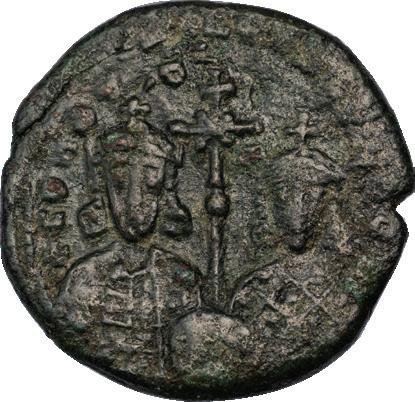

Sear 1762.
Ex Hugh George Goodacre Collection, Downie-Lepczyk Auctions Sale 70, 9/17/1986, lot 221 (with original auction label) and a small circular tag citing earlier provenance as “Ratto 1907.” VF, attractive glossy dark green patina.
82 (18476). BYZANTINE EMPIRE. BASlL II and CONSTANTINE VIII, AD 976-1025. Gold histamenon nomisma, 4.43 g, 29 mm. Issue of Constantinople. Obv. +IhS XPS RЄX RЄGNANTIЧM, bust of Christ Pantocrator, facing, crescent ornaments in nimbus, holding the Gospels and raising his right hand in benediction. Rev. + bASIL Є CONSTANT IbR, busts of Basil II and Constantine VII, both facing and holding a plain cross between them.
Sear 1800.
NGC graded CHOICE AU STAR, Strike 5/5, Surface 5/5, an exceptional specimen of this coinage that has earned NGC’s coveted STAR designation as well as the top 5/5 rating for both strike and surface.
83 (18680). BYZANTINE EMPIRE. ISAAC I, AD 1057-1059. Gold histamenon nomisma (skyphate), 4.44 g, 26 mm. Issue of Constantinople. Obv. + IҺI XIC RCX RЄGNANTIҺm, Christ Pantocrator enthroned, facing, holding the Gospels and raising his hand in benediction. Rev. + ICΛΛKIOC RΛCIΛЄVC PƜM, emperor, standing, grasping scabbard and holding sword.






Sear 1843.
Ex Mike Gasvoda Collection; ex CNG Electronic Auction 475, 8/26/2020, lot 663 = Andre Constantine Dimitriadis Collection, Heritage 3035, 9/3/2014, lot 29666 = Sotheby’s New York, 12/9/1993, lot 630 (part of).
NGC graded CHOICE AU, Strike 4/5, Surface 4/5.
53
84 (18624).
BYZANTINE EMPIRE. CONSTANTINE X, AD 1059-1067. Gold tetarteron nomisma, 4.10 g, 19 mm. Issue of Constantinople. Obv. Bust of the Virgin Mary orans, facing, wearing tunic and maphorion, MHP-ΘV (mother of God) in fields. Rev. +KωN RACΔ O ΔVK, bust of Constantine X, facing, holding globus cruciger and akakia Sear 1849.

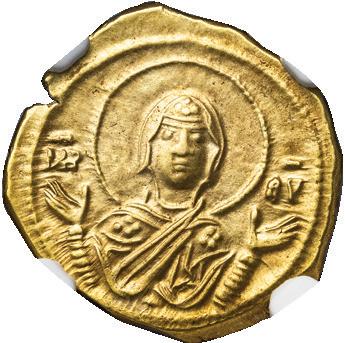

NGC graded CHOICE AU, Strike 5/5, Surface 5/5, scarce, exceptional specimen with NGC’s top 5/5 rating for both strike and surface.
85 (18683). BYZANTINE EMPIRE. MICHAEL VII, AD 1071-1078. Gold/electrum histamenon homisma, 4.38 g, 29 mm. Issue of Constantinople. Obv. Bust of Christ Pantocrator, facing, holding the Gospels and raising his right hand in benediction, IC-XC in fields. Rev: + MIXAHΛ RACIΛ O Δ, bust of Michael VII, facing, wearing loros, holding labarum and globus cruciger. Sear 1868.
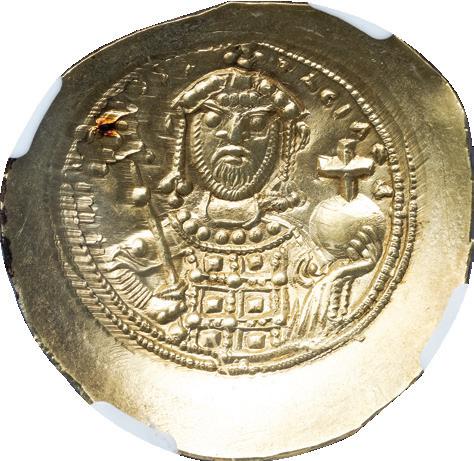
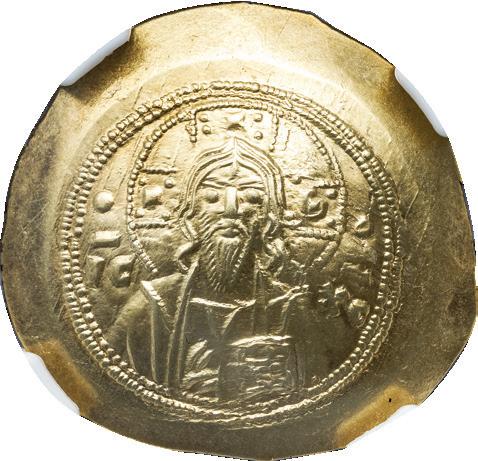


Ex Mike Gasvoda collection.
NGC graded MINT STATE, Strike 5/5, Surface 5/5, exceptional specimen with the NGC’s top 5/5 rating for both strike and surface.
86 (18812). BYZANTINE EMPIRE. MANUEL I, AD 1143-1180. Electrum aspron trachy, 4.25 g, 33 mm. Issue of Constantinople, ca AD 1143-1152. Obv. IC-XC O ЄMMANYHΛ, bust of youthful Christ, beardless, facing, raising right hand in benediction. Rev. MANYHΛ ΔЄCΠOTH, Manuel standing, facing, holding labarum and akakia, being crowned by the Virgin at right, MHP - ΘV in upper field. Sear 1957.

Ex Mike Gasvoda collection; ex Trausnitz collection, Nomos 20, 7/10/2020, lot 453. NGC graded AU, Strike 4/5, Surface 3/5, “scratches,” “edge crimp,” with a pleasing depiction of the young Christ recalling the type introduced by Justinian II during his Second Reign.

54
ORDERING INFORMATION AND TERMS OF SALE
Email: vilmar@aol.com
(Refer to our website for complete terms of sale and bibliographical information regarding abbreviations used)
Prices are listed at the end of the catalogue. The coins also appear as individual records on our website. Please place your orders by email and make reference to the catalogue and/or inventory numbers provided at the beginning of each listing. All coins are offered subject to prior sale and no order is valid until confirmed by us in writing and accompanied by a formal invoice.
OUR GUARANTEE
We unconditionally guarantee the authenticity of all our coins. A coin may be returned for any reason within 10 days, but we ask that you first contact us and ship the piece back fully insured. Upon receipt of the return and providing it is in the same condition as originally sent out, we will issue a refund, minus any shipping and credit card charges. This guarantee does not apply if coins are removed from encapsulation.
NGC ENCAPSULATED COINS
Many of our coins are sold encapsulated in NGC holders. Such coins have been evaluated, graded and encapsulated by NGC Ancients. NGC Ancients does not encapsulate any coins that in their opinion are fakes, of uncertain authenticity or have been repaired. In some cases we offer raw coins, and these may be encapsulated upon request.
PAYMENT TYPES
Title does not pass until payment is made in full. Payment must be received within 7 days of the sale date. In the United States payment may be made by bank wire, money order or personal check drawn on a US bank. CREDIT CARDS (VISA, MC, AM EX) are generally accepted but an additional 4% service charge will be added. Payments from overseas (all foreign countries including Canada) may be made by bank wire.
SALES TAX
Sales tax will apply to all merchandise delivered within New York State and other select states as required.
SHIPPING CHARGES FOR COINS
United States: $50 for FEDEX or EXPRESS MAIL (delivery in 1-2 days within the US). Foreign, including Canada: $120 via fully trackable Fed Ex or USPS Global Express Mail. Please note that it is the responsibility of the buyer to comply with all customs regulations and pay for all duties/taxes in their country.
ILLUSTRATIONS USED IN THIS CATALOGUE
Coins are illustrated 1:1 and in various enlargements. In certain cases, we have also included images of older catalogues or publications where the specific piece is documented.
CREDITS
We are grateful to Oliver Hoover for his assistance in cataloguing and preparing the historical notes, and to Mary Lannin for her editorial help. Photography and catalogue layout are the work of Alex Marinescu of Marinescu Designs, LLC.
WE WILL BE PARTICIPATING AT THE FOLLOWING SHOWS AND LOOK FORWARD TO SEEING YOU THERE ANA 2023 World’s Fair of Money, Pittsburgh, PA, August 8-12, 2023. Whitman Baltimore Winter Expo, November 9-11, 2023.
New York International Numismatic Convention, January 7-14, 2024.

55
ANCIENT COINS – FIXED PRICE LIST V, SUMMER/FALL 2023 – PRICES
ANCIENT COINS – FIXED PRICE LIST V, SUMMER/FALL 2023 – PRICES
ANCIENT COINS – FIXED PRICE LIST V, SUMMER/FALL 2023 – PRICES
56
1. 18177 Celtic tetradrachm $ 1,650 2. 18493 Tarentum didrachm $ 750 3. 18496 Tarentum didrachm $ 850 4. 17445 Tarentum gold ex Vlasto $ 24,750 5. 17756 Metapontum ex Pozzi $ 6,000 6 18637 Gela tetradrachm $ 2,500 7 18499 Syracuse tetradrachm $ 4,800 8 18874 Syracuse tetradrachm $ 13,500 9 18841 Philistis tetradrachm $ 4,850 10.18849 Siculo-Punic tetradrachm $ 11,000 11.14793 Odessus tetradrachm $ 1,200 12.15330 Odessus tetradrachm $ 975 13.18339 Lysimachus tet plate coin $ 3,000 14.18220 Lysimachus stater $ 7,000 15.18676 Phillip II tetradrachm $ 14,850 16.18501 Phillip II 1/5 tetradrachm $ 850 17 18506 Alex tetradrachm $ 750 18 18813 Alex drachm ex Lockett $ 1,250 19 18515 Argos stater $ 1,400 20 18517 Aegina turtle $ 3,500 21.18518 Aegina ex Sartiges $ 5,000 22.18519 Aegina obol $ 1,300 23.18522 Corinth stater vase $ 2,250 24.18525 Corinth stater eagle $ 1,500 25.18745 Cydonia turtle $ 6,500 26.18700 Sycion ex Knoepke $ 8,500 27 18746 Cyzicus hecte ex Rosen $ 3,500 28 18794 Mytilene hecte ex NFA $ 4,750 29 18747 Phocaea hecte lion $ 2,850 30 18462 Cnidus ex Prince Waldeck $ 7,500 31 18533 Antiochus I tetradrachm $ 1,500 32.18569 Demetrius I dog AE $ 7,850 33.18535 Antiochus VIII tet $ 850 34.18536 Antiochus VIII tet $ 1,200 35.18537 Selecus VI tet overstrike $ 1,200 3618549 Aradus tet plate coin $ 2,250 37.18259 Sidon 1/16 shekel plate $ 850 38.18303 Tyre didrachm $ 1,850 39 18386 Tyre shekel Cohen plate $ 3,250 40 18543 Jewish shekel Yr. 1 $ 21,000 41 18699 Jewish shekel Yr. 2 $ 12,500 42 18675 Jewish half shekel Yr. 2 $ 29,850 43 18544 Sela Hendin plate coin $ 14,500 44.17435 Silver zuz $ 2250 45.18545 Sela ex Hendin and Levin $ 10,500 46.18014 Silver Zuz w/overstrike $ 3,250 47.18753 Octodrachm Berlin dupl. $ 45,000 48.18796 Octodrachm Sidon $ 39,500 49.18826 Fostlus denarius $ 950 50 18832 Anonymous denarius $ 950 51 18824 Lepidus denarius $ 550 52 18827 Sulpictus Galba denarius $ 1,500 53 18825 Limetanus denarius $ 800 54.18831 Brutus denarius $ 1,800 55.18836 Caesar portrait denarius $ 4,800 56.18820 Augustus denarius $ 1,500 57.18829 Tiberius denarius $ 1,500 58.18823 Nero Blaundos AE $ 1,500 59 18834 Nerva denarius $ 750 60 18828 Trajan Column denarius $ 1400 61 18830 Marcus Aurelius denarius $ 750 62 18833 Marcus Aurelius denarius $ 750 63 18835 Faustina denarius $ 350 64.18837 Augustus aureus ex 1949 $ 13,500 65.18821 Augustus denarius $ 4,000 66.17884 Augustus ex Huntington $ 1,800 67.18838 Tiberius denarius w/color $ 7,000 68.18465 Caligula denarius $ 7,500 69.18562 Claudius denarius $ 5,950 70.18822 Claudius as ex 1922 $ 4,700 71 18674 Nero Port of Ostia $ 37,500 72 18619 Vespasian denarius $ 2,800 73 18467 Sept. Severus aureus $ 21,750 74 18844 Gordian III Hydra Labor $ 1,800 75.18839 Gordian III Hind Labor $ 5,000 76.18468 Constantius I aureus $ 15,750 77.13458 Licinius I aureus unpub $ 24,500 78.18845 Constantius II ex Jameson $ 19,500 79.18843 Contorniate of Sallust $ 5,900 80.18472 Petronius Max solidus $ 17,500 81.18033 Constantine VII AE follis $ 300 82.18476 Basil II histamenon $ 4,750 83 18680 Issac I histamenon $ 1,750 84 18624 Constantine X tetarteron $ 3,000 85 18683 Michael VII histamenon $ 2400 86.18812 Manuel I trachy $ 800
1. 18177 Celtic tetradrachm $ 1,650 2. 18493 Tarentum didrachm $ 750 3. 18496 Tarentum didrachm $ 850 4. 17445 Tarentum gold ex Vlasto $ 24,750 5. 17756 Metapontum ex Pozzi $ 6,000 6 18637 Gela tetradrachm $ 2,500 7 18499 Syracuse tetradrachm $ 4,800 8 18874 Syracuse tetradrachm $ 13,500 9 18841 Philistis tetradrachm $ 4,850 10.18849 Siculo-Punic tetradrachm $ 11,000 11.14793 Odessus tetradrachm $ 1,200 12.15330 Odessus tetradrachm $ 975 13.18339 Lysimachus tet plate coin $ 3,000 14.18220 Lysimachus stater $ 7,000 15.18676 Phillip II tetradrachm $ 14,850 16.18501 Phillip II 1/5 tetradrachm $ 850 17 18506 Alex tetradrachm $ 750 18 18813 Alex drachm ex Lockett $ 1,250 19 18515 Argos stater $ 1,400 20 18517 Aegina turtle $ 3,500 21.18518 Aegina ex Sartiges $ 5,000 22.18519 Aegina obol $ 1,300 23.18522 Corinth stater vase $ 2,250 24.18525 Corinth stater eagle $ 1,500 25.18745 Cydonia turtle $ 6,500 26.18700 Sycion ex Knoepke $ 8,500 27 18746 Cyzicus hecte ex Rosen $ 3,500 28 18794 Mytilene hecte ex NFA $ 4,750 29 18747 Phocaea hecte lion $ 2,850 30 18462 Cnidus ex Prince Waldeck $ 7,500 31 18533 Antiochus I tetradrachm $ 1,500 32.18569 Demetrius I dog AE $ 7,850 33.18535 Antiochus VIII tet $ 850 34.18536 Antiochus VIII tet $ 1,200 35.18537 Selecus VI tet overstrike $ 1,200 3618549 Aradus tet plate coin $ 2,250 37.18259 Sidon 1/16 shekel plate $ 850 38.18303 Tyre didrachm $ 1,850 39 18386 Tyre shekel Cohen plate $ 3,250 40 18543 Jewish shekel Yr. 1 $ 21,000 41 18699 Jewish shekel Yr. 2 $ 12,500 42 18675 Jewish half shekel Yr. 2 $ 29,850 43 18544 Sela Hendin plate coin $ 14,500 44.17435 Silver zuz $ 2250 45.18545 Sela ex Hendin and Levin $ 10,500 46.18014 Silver Zuz w/overstrike $ 3,250 47.18753 Octodrachm Berlin dupl. $ 45,000 48.18796 Octodrachm Sidon $ 39,500 49.18826 Fostlus denarius $ 950 50 18832 Anonymous denarius $ 950 51 18824 Lepidus denarius $ 550 52 18827 Sulpictus Galba denarius $ 1,500 53 18825 Limetanus denarius $ 800 54.18831 Brutus denarius $ 1,800 55.18836 Caesar portrait denarius $ 4,800 56.18820 Augustus denarius $ 1,500 57.18829 Tiberius denarius $ 1,500 58.18823 Nero Blaundos AE $ 1,500 59 18834 Nerva denarius $ 750 60 18828 Trajan Column denarius $ 1400 61 18830 Marcus Aurelius denarius $ 750 62 18833 Marcus Aurelius denarius $ 750 63 18835 Faustina denarius $ 350 64.18837 Augustus aureus ex 1949 $ 13,500 65.18821 Augustus denarius $ 4,000 66.17884 Augustus ex Huntington $ 1,800 67.18838 Tiberius denarius w/color $ 7,000 68.18465 Caligula denarius $ 7,500 69.18562 Claudius denarius $ 5,950 70.18822 Claudius as ex 1922 $ 4,700 71 18674 Nero Port of Ostia $ 37,500 72 18619 Vespasian denarius $ 2,800 73 18467 Sept. Severus aureus $ 21,750 74 18844 Gordian III Hydra Labor $ 1,800 75.18839 Gordian III Hind Labor $ 5,000 76.18468 Constantius I aureus $ 15,750 77.13458 Licinius I aureus unpub $ 24,500 78.18845 Constantius II ex Jameson $ 19,500 79.18843 Contorniate of Sallust $ 5,900 80.18472 Petronius Max solidus $ 17,500 81.18033 Constantine VII AE follis $ 300 82.18476 Basil II histamenon $ 4,750 83 18680 Issac I histamenon $ 1,750 84 18624 Constantine X tetarteron $ 3,000 85 18683 Michael VII histamenon $ 2400 86.18812 Manuel I trachy $ 800
57














 MICHEL P. VLASTO AND PLATED IN HIS
MICHEL P. VLASTO AND PLATED IN HIS













































































































































































 OLIVIER & LORBER
OLIVIER & LORBER



































































































































































